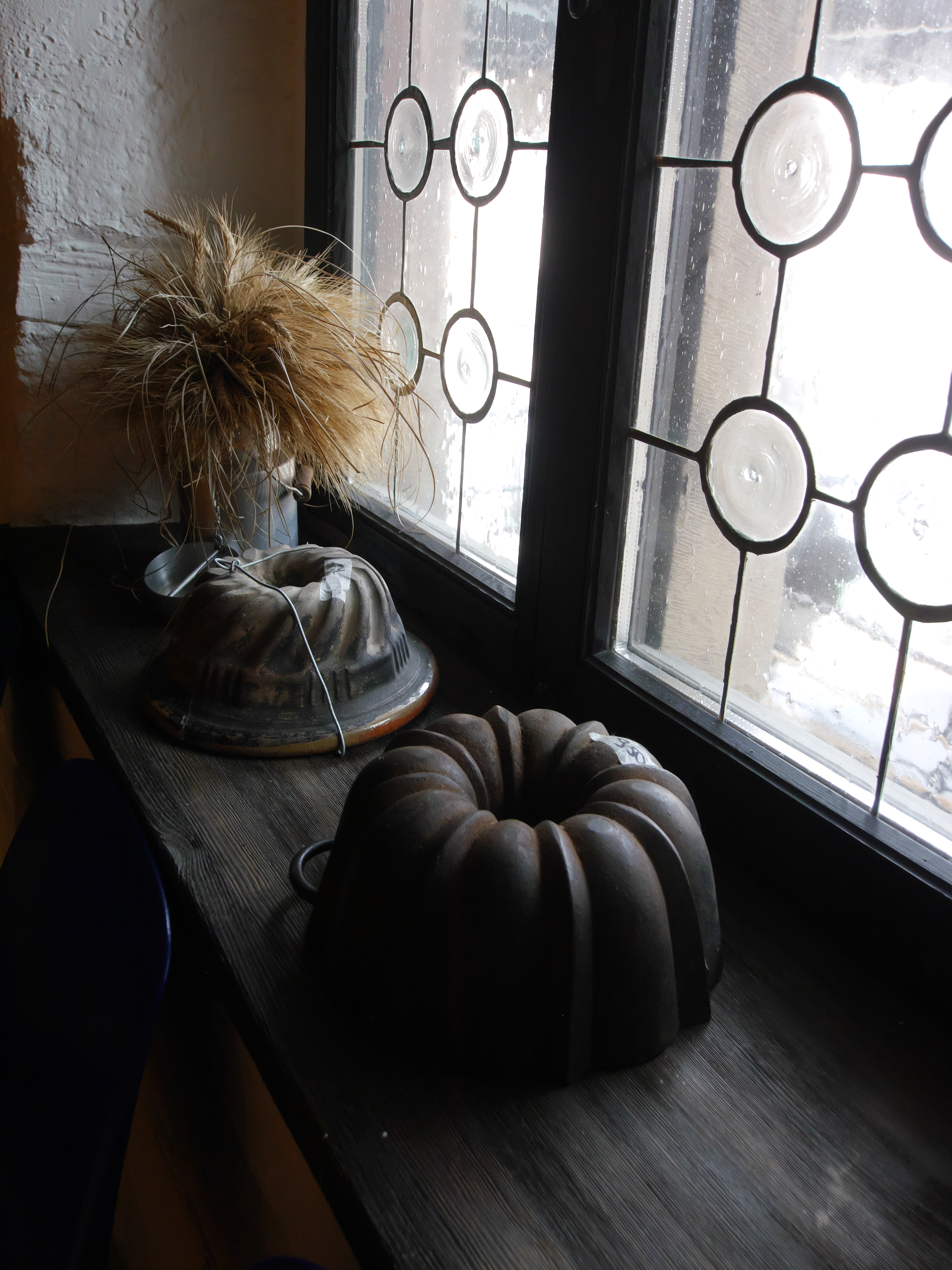 And this time too we did it!
And this time too we did it!
To do… what?
Not to catch Covid, and what else. We have been to France and Switzerland, countries where masks are not mandatory, and therefore their use is very limited and absolutely discretionary. Not to mention Turkey, especially in Istanbul, where the famous lady "There is none Coviddi" should be conferred honorary citizenship.
About our organized trip to the Erdoğan Sultanate, of its lights and shadows maybe we will write about it in the future since this post is dedicated to the expedition exhibition in Alsace, cleanse, as always, from my personal tour guide.
Just to get off to a flying start, I want to put a full stop right away, or that this trip was the last nail planted in the coffin of my train journeys for which a connection is scheduled in Milan. NO MORE.
Not to compete with his Frecciarossa for Paris, Trenitaglia has decided well to let Thello die, the night train on the Venice Santa Lucia - Paris Gare de Lyon route. Too convenient for us to get off in Dijon in the morning and from there get on a TGV to Strasbourg, really too comfortable. So we were forced to take an arrow to Milano Porta Garibaldi, arrow so to speak since it arrived late, and then scramble to figure out where the train for Basel would soon be leaving from. In fact, the station is very lacking in information on the platforms, situation made even more complicated by the fact that to move from the passing tracks to the leading ones, you have to undertake a labyrinthine and poorly marked path. Just so as not to be proven wrong, on the way back, the train platform for Venice was specified only a few minutes before departure. Already us with two children trolley we struggled hurrying up and down corridors and stairs to the platform, so I wonder if those warmers hired for competition realize how complicated it can be to move there with a baggage that is only slightly more bulky and perhaps with some mobility difficulties.
When I happen to return to Alsace, I will leave Austria, from Villach via Mannheim or with the beautiful nightjet Wien - Strasbourg, or again, extreme reason, with Flixbus from Venice (plane also no, thank you), and the same anathema also applies to all the other trips that I will have the good fortune to make in Europe.
Bene, now that I have taken this pointed pebble out of my shoe I can move on to more pleasant things, ovvero il European Patchwork Crossroads 2022.
As always, I settled in Sélestat, strategically perfect position to reach the Val d'Argent and the other suggestive Alsatian towns, as well as a very quiet village, very different environment from the Disney chaos of Colmar. This year my personal travel agency has found a suggestive attic in a 15th century building declared a historical monument in the 1984. What more could you ask for?
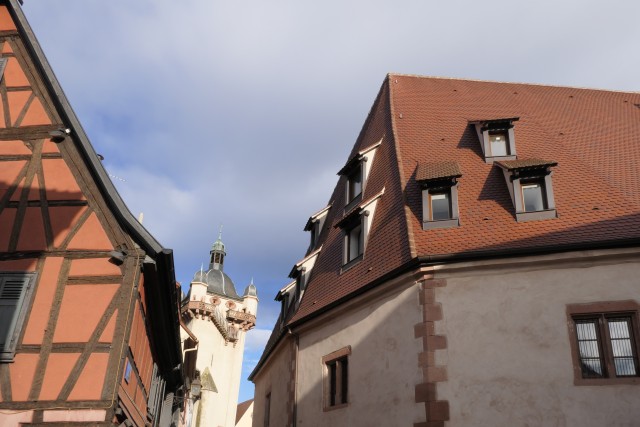
Ah sì, we could add that the Sélestat bus station has been completely redone, now equipped with large canopies so as not to get wet when it rains. One morning we happened to notice a gazebo next to the station. At first we had thought of a commercial activity or an event of some association looking for signatures and subscriptions. Instead it was a GrandEst initiative, the local public transport company. Basically they were advertising the opening of a new bus line, complete with information leaflets and updated timetables. Just like us ...
Basta, better change the subject, the more I think about how (non) things work here and the bile rises, better to talk about fabrics (e non solo…).
Vote of the twenty-seventh edition of the Carrefour Européen du Patchwork: 7+.
Ne valeva la pena. I came home feeling like I saw a lot more than I was able to memorize at the moment, and this post it offers me the opportunity to see them again to appreciate them again as they deserve, perhaps even to understand its meaning.
Come si dice, fuori il dente fuori il dolore, so let's talk about the "Au fil des contes" competition right away, whose theme asked to represent what marked the imagination of one's childhood, tales, characters, dreams and memories.
I have to tell the truth, I feared an invasion of stereotypical characters, Little Red Riding Hood, Cinderella, the little Mermaid, Pinocchio, wolves, orcs, smurfs, draghi, mice, little pigs, gatti, ducklings and so on and so forth. Instead, to my great relief, I was proven wrong. Except for some easy fairy-tale references, I must say that most of the competitors interpreted the theme with sufficient freedom and appreciable originality.. It's obvious, not everything met my tastes, and as always I only partially shared the jury's choices. By now it is known that features such as the special effect for its own sake, the pimp representation, la furberia, the technique uncertain, il politically correct they make me hives, however, I had already decided to postpone and concentrate on the works that told me something original and harmonious.
So here is the work that immediately impressed me and that in my heart I hoped that its value would be recognized, which actually happened.
Look and marvel. I cannot find the words to describe the elegance of this work, a simple subject, solid, understandable, yet imbued with that oriental mysticism that still resists globalization and time.
This is not a trivial ceramic bowl, è un Chawan o one Tenmoku (only the author could be more specific), i.e. a bowl for the tea ceremony, that ritual that dates back to the 12th century.
The artist recalls when her mother filled in for her, then little girl, that bowl, not just very clear tea, but also of light and love. Now it is the children of Tark Jungeun who enjoy the same magic contained in this bowl, and hopefully the spell won't be lost in generations to come.
If I may make a criticism, I think a stiffer mount should have been used for the backing. In fact, the work presented a considerable flatness defect probably due to sudden changes in temperature and humidity, a venial sin which in any case did not diminish its beauty.
I don't know anything about Mattea Jurin, and I worry about it as his quilt “Big girls don’t cry” reveals her as an artist worthy of attention.
The choice of colors is perfect, as well as the tormented composition of the trees. Both convey a sense of impending menace, a gloom not entirely dispelled by the more lively colors that filter through the branches. I like to think that the little girl on that path is creating a beacon of hope by herself, and to do this, you just need to convince yourself that even if you are small, you are still big inside, and big girls don't cry, they deal with problems.
Compliments of Mattea Jurin, for the artistic part of the work it is obvious, but above all for the interpretative choice of the theme of the competition, the memory of anxieties of a distant time that she was able to overcome with courage and determination.
Baba Jaga, Medea, Circe, Lilith, and now I have made the acquaintance of Bruja Piruja, a witch very different from her more famous colleagues. It's sort of Till Eulenspiegel al femminile, a mischievous witch and also a bit’ unfortunate who lives in a cave full of junk. For the law of retaliation one morning is struck by “witch's blow”, remaining immobilized in bed. With the help of his crow he will be able to heal, but only after promising not to cast spells again. Ma… it really will?
How not to be attracted by that bewitching half gaze? It may have the same power as Medusa. The eye and the mouth stand out diabolically his figure that the black and white draw like an insistent musical rhythm that does not leave a moment of breath.
Allora, to lighten the atmosphere I give you this nursery rhyme.
This is one of those jobs that we never get tired of looking at.
In fact I know little or nothing about Lucy Pevensie, a character from the saga de “The Chronicles of Narnia” the C. S. Lewis., except what I read on Wikipedia. A quanto ho capito, crossing a magical portal inside a wardrobe she finds herself in a world where winter lasts a hundred years due to a spell by the White Witch.
Courageous Lucy will face ups and downs, until the defeat of the witch.
The author represented Lucy in that frozen world next to the famous live street lamp, but the dynamism of the child will be able to change things, and you can already guess it from the warmer colors behind the trees.
It is a fascinating image, full of color and light, even where everything fades to grey, and it looks like Lucy is about to step out of the picture.
Me and my sherpa / photographer / webmaster / translator / pusher / tourist guide / ecc. we stopped for a long time to observe this work trying to grasp its message. The titles had not yet been displayed, therefore we enjoyed maximum interpretative freedom. I have to admit that he immediately recognized a piano keyboard, and then it remained to explain the reason for that image “move”, as if you were looking at something through a slightly rippling surface of water.
The only explanation was that it was a memory, what the mind retains but is unable to report with absolute precision, on the contrary, most of the time it is a complex work of mediation.
We were right.
The author recalls her youthful dream of becoming a great pianist, but also the suffering and loneliness that the study of that instrument entailed, so much so that it makes me think of an image seen through a veil of tears.
Also in this case, regardless of the artistic quality of the work, I have to congratulate how Kang Geunhea has managed to give an original visible form to the theme of the competition.
Maybe in this case mine sherpa / photographer / webmaster / ecc. he immediately recognized in that image the visual representation of a handwriting from his book “365 fresh eggs”:
Gianografia n°159 – GHOSTS
It doesn't take much to remember the past, but to remember the future a good dose of memory is essential. If you are not convinced, try to recall your dreams of the past.
Of course, direct references to fairy tales could not be missing, and of all the works this one by Kestrel Michaud is the one that amused me the most.
While not reaching the fame of the most famous stories written by the Grimm brothers (snow-white, Cinderella, Little Red Riding Hood, tanto per citare dei titoli), the fairytale “The Town Musicians of Bremen” it stands out for some surreal aspects, due to the absence of any pedagogical or edifying aspect, and for the fact that everything happens according to chance and luck. Not for these reasons should it be considered a fairy tale “minor”, especially if we reflect on how much chance and luck prevail even in the distant past (in time and space) collection of short stories “Le mille e una notte”.
It goes without saying that to make this even more valuable quilt it wasn't just the choice of the theme, but also its graphic representation. Kestrel tries to obtain a three-dimensional suggestion from his works, and once again with a skilful play of shadows and transparencies she managed to create a lively scene, and moreover one expects at any moment to hear braying, bark, meow and sing.
If you don't remember how that fairy tale did, enjoy the narration of Vittorio De Sica (sorry if it's too little…) broadcast by Rai in 1961, when television still had some educational function and we went to bed after Carosello.
You can find other more or less interesting works in mine galleria Flickr dedicated to exhibitions of 2022, oppure, when will it be available, you could order the Prestige catalog directly from the website Carrefour Européen du Patchwork.
I have not included all the works in the competition here, reserving space for those who have more made my strings vibrate. Don't think about the others quilt they were ugly, indeed in the majority of cases I got a positive impression, però, come dicono gli americani, “not all flavors are vanilla”.
So let's leave the competition and go see the other exhibitions, arriving at an unexpected connection with Fabrizio De André.
The title of this work by Hildegard Mueller is “Raw on Row”, row after row. These are words taken from poetry “In Flanders Fields” by John McCrae, composed in May of 1915 after the second battle of Ypres in which the Canadian lieutenant colonel took part as a medical officer.
|
In Flanders fields the poppies blow We are the Dead. Short days ago Take up our quarrel with the foe: |
Poppies sprout on the fields of Flanders We are the Dead. A few days ago You resume the fight with the enemy: |
During the funeral service for friend Alexis Helmer who fell in that battle, John McCrae watched as poppies thrived around the graves of the fallen, and from that image he drew the inspiration for his poetry.
How then do not also remember the verses de “Peter's War”, written almost fifty years later by Fabrizio De André?
You sleep buried in a cornfield
it's not the rose it's not the tulip
who watch over you from the shadow of the ditches
but they are a thousand red poppies.
I have already had the opportunity to write about Angela Minaudo's skill in post Val d’Argent 2021. This year, space has been reserved for her for an exhibition of her own, a recognition that goes beyond any personal evaluation. There aren't many quilter homegrown who can boast the driving license of “international artist”, and if this can be a reason for legitimate satisfaction, it is also implicitly a condemnation, that of always trying to surpass oneself so as never to disappoint. The premises are there…
Let's stay close to my house and go on a trip to Slovenia.
Almost ten years have passed since the exhibition was held in Kranj “Čas za patchwork“, the first exhibition organized by Margareta Vovk Čalič. Of that experience we have the testimony of a post intitolato “No reason“, in which we report the images of the beginnings of Margareta's group.
Of course find them quilter Slovenians in Val d'Argent had a certain effect on me. In the first place, personal satisfaction prevailed for having seen their first steps in the past and having guessed their qualities, and then it is always hoped that the seeds of the patchwork find new lands, new artists and new forms of expression.
For the moment, the traditional blocks still prevail, but we can already see some interesting artistic projections on the horizon patchwork.
And Mateja Dimnik seems to have taken a path that could take her very far, also because it has time to grow, energy to spend, fantasy to explore, culture from which to fish and a fair amount of recklessness.
After all, whoever tries his hand at black is one quilter sure of herself and of what she intends to express. Too easy and alluring i patchwork made with beautiful colorful fabrics, happy, well matched, while black is challenging, for all, for the contrast, for invasiveness, for the message, and also for the view.
Innovation for innovation, here's one of the strangest things I've seen this year.
It is a texture made of synthetic material, probably hot melt glue, coupled with pieces of plastic packaging film, I assume polyethylene.
Some kind of lace came out of it random, Jackson Pollock style I venture to say, and although at first glance it might seem like the essence of chaos, observing it more closely you notice a precise design, a project.
Certainly more than a few quilter he must have raised an eyebrow at the works of Sandrine Pincemaille, if not, he will simply have considered them “fuffa”, when instead it is a bold experiment where instead of cotton, of polyester, some wool, a liquid thread was used, something very different from a exploit thrown there just to amaze.
I am convinced that these new ways of expression should be judged with an open mind and a willing eye, because it could happen a tomorrow than on a quilt more traditional a bold contamination like this is fine, a futuristic transplant, a iota of madness.
You should already know that I like to jump from post to post, and then here are some jobs “tradizionali”.
I actually put that adjective in quotation marks as this is a made-up tradition, come i kilt Scottish and North American dream catchers.
The panels below are called molas, and are applied to the clothes of the Kuna women of the San Blas Islands, vicino a Panama, and more than a traditional artifact it should be considered as a form of distinctive identity.
Until the early 20th century it was common the body painting, but from the encounter with the colorful fabrics from the continent (also recycled fabrics in the most authentic interpretation of patchwork), as well as by the growing availability of relatively new tools for them such as scissors, razor blades, needles and thread, the idea was born to give a more stable form to their graphic-cultural expression. It must be said that the Kuna have always tenaciously defended their territorial and social independence, until the revolution of 1925 which led them to autonomy from the Panamanian government. Incidentally, one of the sparks that ignited the soul of the revolutionaries was the ban on wearing the molas, which is why we can well understand the cultural value of this garment.
The Kuna have a layered view of the cosmos, eight to be exact, and for the molas a maximum of seven layers are foreseen, since in the eighth there is what they call God and which includes the earth, the ocean, the sun and the moon (the human being is only at the fourth level). A base eight is also their way of counting (fingers that can be touched with the thumb), and if you think it is an antiquated and impractical system, know that octal numbering is also used in information technology.
Drawings can represent real things, like animals or plants, but also to give visible form to philosophical reasoning, such as the involution of a thought or the search for truth, and there are dozens; just to name a few: spiral, turtle, butterfly, arrow, iguana, rainbow, south wind, cushion…
Ops, I almost forgot to explain the main feature of the molas, what makes them unique. The drawings are born for “subtraction”, that is, by cutting the upper layer, the color of the lower layer appears, and so on from level to level until the drawing is completed. Let's say that in difficulty it is on a par with Hlebine's glass paintings, that too is an art form absolutely naïve.
Huehuetenango saw says niente? No, he is not a Mayan deity. Then maybe Antigua? I guess you are thinking of that island in the Lesser Antilles, but even in this case you are off track. Both are the names of two of the best coffee production areas in Guatemala.
At this point it would be logical to suspect that I like coffee, and you would be one hundred percent right.
I love coffee, black coffee without sugar, because Guatemalan Bourbon is already as sweet as its own. If you like go and see like mine sherpa / webmaster / photographer / ecc., and now too barman, prepare me the “Capo in B”, a typical café of the area where I live. Who he post relative “The most beautiful moment of the day“.
So how could a work with a title not attract me “Black Coffee”?
However, I don't appreciate only coffee from Guatemala, but also the wonderful works of Priscilla Bianchi, with the warm colors of its land. She loves using Guatemalan fabrics to keep traditional motifs alive and current by always giving them new configurations, an aesthetic mix that well defines his artistic commitment and respect for an ancient and never lost culture.
TELAS is an acronym for The East Los Angeles Stitchers, a group of female artists that promotes i quilt of the Southern California Latino community. Panels referencing the Día de los Muertos have been created based on models designed by the late Jane Tenorio-Coscarelli (the day of the dead), a Mexican celebration in remembrance of the dead.
It is difficult for us to understand the almost carnival spirit of that ceremony, and after all its origins are lost in the pre-Columbian era, when the relationship with death and with the dead was lived in a more intimate way, more passionate, almost bidirectional. Perhaps the centuries of uninterrupted human sacrifices in honor of terrible bloodthirsty deities have influenced the formation of this way of seeing.
One could assume that Yvette Campos-Kratzeisen also has South American roots, and instead she is a DOC Alsatian who fell in love with Inca motifs, maya, Aztecs and more. By revisiting them according to his taste, he has given them new life, new colors, new suggestions.
Its mode of operation is similar to Chinoiserie del XIX secolo, when European artists loved to put Chinese motifs on their works, decorations which, although not perfectly faithful to the original ones, still managed to convey a sense of exoticism and refinement.
Undoubtedly this is another way of interpreting the patchwork, and I confess that I am not sorry at all. In addition to the intriguing aesthetic effect, it must be said that these panels betray an out of the ordinary manual skill. Complimenti.
No, these are not Mayan temple ruins, have returned this side of the Atlantic Ocean, as did Denise Labadie about twenty-five years ago, traveling from the USA to Ireland to visit the land of his ancestors.
The effect that reality of such ancient stones had on her, so solid, so immutable it was overwhelming and definitive, almost equal to the lighting of St. Paul on the road to Damascus. Since then she has always returned to those old stones, to observe them, to feel its transcendence, to warn the centuries of history that have barely touched them, and above all to listen to its message. Because she became so intimately connected with them that she accepted them and learned their language, listen to the words whispered to whom, among the fleeting essences of flesh and blood, knows how to listen.
What she does is not just a suggestive textile work, it is instead the attempt to bring back to us those secret messages so that we can understand how ridiculous the human illusion of power is.
Bonamargy Friary in Ireland dates back to 1485, and among its ruins very ancient documents have been found, including one of the main theological works of St. Thomas Aquinas.
Even older is the site of Glendalough Monastery whose foundation dates back to the 7th century. Today it has become one of the main pilgrimage attractions of medieval Ireland. Its ruins and others similar can be visited within a natural park of ben 200 square kilometers.
Not so old but old enough are the things that Françoise Grall likes to put on fabric.
Its origins are Breton, those of a promontory that wedges into the Atlantic Ocean and obtains its favors and punishments in equal measure.
It was logical that he saw boats, and even those no longer usable that ended up in some hull cemetery to be “cannibalize”. Undoubtedly those youthful memories have remained with her, so much so as to push her to try to give visual form to those melancholy sensations.
Thanks to your preparation (he studied chemistry) and brilliant technical solutions has explored the possible connections between thickness and fabric, matter and color, sewing tools and instruments, and she succeeded, by methods which I will not reveal here, to get representations “material” worthy of a pictorial art exhibition.
I have entered them here “solamente” three of his works, a malincuore. I wanted to show them all, but I would have risked subjecting you to the dictatorship of my personal taste, since these were for me among the best works of this edition of the Carrefour Européen du Patchwork. Comunque, for those who wish, there is always my album on Flickr to see more.
Contamination, che passione!
Purity is beautiful, it is measured, she is true to herself, but sometimes also sterile and cloying. How much more I like unlikely unions, amazing, audaci, but also daughters of passionate aesthetic choices.
Natalia Lashko was born Russian, a few kilometers from the banks of the Don, but today he lives in Ukraine, and of that land it brings back the popular themes. It does, when it comes to contamination, with straw embroidery, a technique born in Russia in the 16th century in imitation of gold.
Poteva bastare? Not a chance.
Her son Illyaz joined her, and with him came new ideas and less formal perspectives, yet another contamination.
I had already seen an opera by Natalia Lashko in Verona in 2019 (qui the related post), however this straw embroidery technique was a really interesting discovery.
Ok, now that we have discovered straw embroideries we can move on to the department “strange things”.
Monique Alphand, Marithé Malferiol and Michel Perrier are three textile collectors who have decided to offer a different vision of the antique patchwork French. One might think that the word being English “patchwork” also this technique of cutting and sewing is a prerogative of the Anglo-Saxon world.
Mistaken.
Apart from the fact that the former patchwork (Leather) they were found in the Egyptian ruins of a few thousand years ago, apart from the fact that the term “quilting” comes from the Latin “mattresses“, apart from the fact that in Persia the nomads already assembled the Kilim carpets, except that Mennonites and Amish are originally from Saxony, of Switzerland and Alsace, apart from all this, the use of reassembling pieces of fabric to make objects of domestic use or furniture was also widespread in France.
The biggest difference is the result of cultural distance (and geographic) tra il patchwork Europe and that of the British overseas colonies, then you become the federation of the United States. In the latter the lack of raw material, deliberately caused by the British to maintain the exclusivity of textile production, resulted in the pressing need to reuse every square inch of fabric even whip to make quilts to be stuffed, first with dry leaves and then with more durable materials, while in Europe the decorative aspect sometimes prevailed.
An example of this is this panel of wool tabs (not very old actually), in which matters of an absolute daily life are represented, memories, personal events, anniversaries and so on.
And what about this beautiful wool panel finely embroidered with elegant appliqué of flowers? The initials suggest that perhaps it was made to celebrate two newlyweds, maybe not for the wedding day but for an important anniversary.
When we say to be passionate about patchwork…
Caroline Legrand worked as a graphic designer and is one of the co-founders of the Théâtre du Soleil (in every way), to finally become one designer textile. Her profession has brought her into contact with textile cultures from all over the world, and she decided to make it an object of study, a research that has allowed her to publish numerous beautifully illustrated books.
In Val d'Argent you brought some pieces from your rich collection, like these garments of Vietnamese origin,…
… or this intriguing blanket from India, a medley of colors which, by virtue of something undoubtedly magical, are held together in any case.
Also from India comes this Banjara dress, a commercial caste very jealous of its textile traditions. In the background an antique patchwork americano (Catherine Legrand collection) with colors well in tune with the dress. Congratulations to Liliane and Armel Chichery for the happy exhibition choice.
Another collector who fishes textile objects from all over the world is Tuulikki Chompré.
What you see below was not meant to be worn, and not even hung on a wall. It is part of a rich camel harness used for a Turkmen wedding ceremony.
From Nicole Roca's collection here are five panels from the Democratic Republic of Congo. I don't know the period of realization of these panels, however, thinking of the troubled and bloody history of that country it can be said that they are precious objects, almost gods “survivors”.
After this world tour (but that's not all…) let's go back to good old Europe.
Eszter Bornemisza non si ripeta mai. While retaining its own style that plays on transparency, on the shadows, on inconsistency, on fragility, always manages to shape (almost immaterial) to some images from which it is difficult to take your eyes off.
Nothing is explicit in his compositions, everything must be sought, interpreted, accepted, one must simply surrender to the suggestion that they transmit.
It is not the first time that Etsuko Ochiai exhibits in Val d'Argent. His specialty was, ed è, the indigo dyeing of the fabric done with traditional Japanese methods. For this work you have decided to go beyond two-dimensionality by applying on the base (polyester?) a fleece of silk curls, probably raw silk, a work of extreme patience. The question arises spontaneously: but how did he keep them together?
Dunque, in recent years I have seen the use of everything in the patchwork. In addition to the very common cotton, lana, seta, polyester, also leaves, glass, plastic, electric wires, carta, organza, parchment, egg shells and more that I can remember at the moment. But I did not expect this material, it was a real discovery, one of the most intriguing works of the exhibition.
Orange peels, this is what this work is made up of, and I will tell you, the effect was surprisingly pleasant.
I have no idea how it all fits together or even how it can keep its appearance unchanged. Maybe it should be considered ephemeral art like i mandala of granules of colored pebbles from Tibet, whose physical existence is limited, however, their beauty affects the memory so much as to guarantee their lasting existence.
I confess I don't know what it is zumkou, I could assume a traditional dress, but I won't venture any further. I would ask anyone who knows anything about it to enlighten me on this. However these works by Martine Molet Bastien are very beautiful, with their bright colors and an original assembly crazy that transfigures them.
We now come to a work for which I can find no adjectives (impressive? Monumental? Immeasurable? Incredibile?). Fate voi.
The Coronavirus has changed many of our habits, and not always for the better, but its greatest impact was when quarantine measures were applied to curb its spread. During that period of house arrest it was all too easy to get discouraged, lose the inspiration and happiness of creating, be oppressed by a gloomy vision of the future.
Cecilia Koppmann rebelled against that state of affairs, decided to keep the delicate texture that ideally unites the quilter of all the world, and he did it thanks to that only window still available: internet. Day after day, he spread short videos on the net illustrating the techniques for making a block, suggesting that you follow her in making a quilt. Più di 600 people from 26 different countries joined his initiative, which in that terrible period almost had the value of a psychotherapeutic session.
Poteva bastare? Not a chance.
She asked those who had attended to send her a block of 4″ representing a house, and the underlying work was born from the union of those tiles
A difficult job, difficult to communicate, difficult to organize, difficult to assemble, and I confess also difficult to photograph, for its size in the first place, but also because it attracted so much attention that there was never a completely unobstructed view to capture the full picture.
In the video below, Cecilia Koppmann talks about the genesis and development of her initiative, and on this page dedicated to Quarantine collective quilt you can find the names of those who participated.
Cecilia Koppmann is Argentinian, so I take the opportunity to show you some interesting works from Spanish-speaking lands, an insert that in this edition of Carrefour Européen du Patchwork has shown that there are still lands to explore.
An almost psychedelic image in this work by Blanca García. Undoubtedly the two spheres seem to emerge from the flat surface of the fabric, and geometric references complete the work.
Maybe I wouldn't keep this one hanging in the house patchwork, it would be a bit’ too aesthetically invasive, but you have to admit that this is a superb realization.
This is certainly more relaxing patchwork in Teresita Leal, a pictorially perfect picture.
I like that she didn't pay too much attention to the details, indeed some small imperfections make everything more natural and fluid, while the choice of colors and chiaroscuro denotes the soul of a true artist.
Carolina Oneto needs no introduction, in each of his quilt she represents spaces, volumes and colors in always fascinating combinations, textile architectures held by virtue of an artistic studio (and maybe even a mathematician) accurate.
Isabel Muñoz arrived in Alsace with works of strong emotional impact, bold blacks and whites and refined representations. As always my choice is the most unlikely, i.e. this school of imaginary fish, a risky chromatic choice, a bet that won anyway given that the structure of colorful strips gives those figures the illusion of movement.
Mi ricordo di Inmaculada Gabaldón, of “La caverna de los sueños“, un quilt admired during that splendid trip I made to Sitges. Today I find out that you love Venice very much (but who doesn't like it?), its calluses, its light, but it is when the carnival arrives that she finds herself in the crazy universe of creative inspiration.
Appearances are deceiving, this is the title of his work, and one could think of a connection between the illusory vanity of appearances and the ephemeral life of soap bubbles, while the solution is much simpler but no less original. The female figure made up by clown he is actually a man, and this should make us reflect on the fact that in the end we trust appearances, and by them we willingly allow ourselves to be deceived.
The impression is that of standing on the ground and watching a hot air balloon rise into the sky.
Even if it is probably the textile reproduction of a photograph, Carmen Santamaria chose the shot perfectly, perspective and colors.
Hat.
Cecília and Mercè González are the two components of the Desedamas group, which decomposed into “more silk” means in spanish “more than silk” (i.e. beyond silk). The raw material they use is mainly silk, which is from time to time support, palette, brush, luce, shadow, border and sky, with always surprising results (maybe even for them).
For some time now they have been experimenting with synesthetic experiments, that is, with color and shape they try to recall sensory stimuli other than sight, like heat, the scent, the taste, eccetera.
Già nel 2015 I was able to admire their organoleptic recalls, I remember well “Cheese with jam” e “chocolate”, but this time they tried something more difficult, something abstract: the music
Below is the work dedicated to Chavela Vargas, pseudonym of Isabel Vargas Lizano, the costarican singer (but Mexican by adoption) which marked a turning point in the iconography of the female singer, at least in Central America, like what Marlene Dietrich was doing in the same years, the latter, however, richly supported by the entertainment industry.
With Frida Kahlo and Tina Modotti she was part of the trio of women who gave an independent form to the female figure.
Cecilia wanted to recall the flaming color of Chavela's inextinguishable passions, the passion for music, the passion for tequila, the passion for women, the passion for life.
Since the work is synesthetic, you should also touch it with your fingers to feel the softness of the velvet, the same of his poignant songs and his voice slightly hoarse from smoke and alcohol.
If you are curious to know how Chavela sang, here is one of his most famous songs below “black pigeon”, in which the singer expresses her pain at the fact that a woman had broken her heart.
Maybe at this point there are those who wonder what happened to them patchwork tradizionali, if they still exist.
No fear, there were those too, including Amish works, but please forgive me, I didn't bother traveling twelve hours plus all the anger to see things that I already know better or worse. Scrolling (quickly) the rooms where they were exhibited, I was able to notice that the quality of execution is always excellent, definitely unattainable for me, but they didn't tell me much, they haven't done it for years.
In any case, here are some examples of which works lovers of tradition could enjoy.
Strange but true, it seems that even in Australia there are parking problems, and perhaps this recurrence of tesserae crazy it depicts the effort and patience to be able to find the right place to leave the car.
Here is the only one quilt by Kristel Salgarollo that we managed to photograph well. Villa Burrus was packed with people, therefore it was impossible to capture an image without something foreign entering the frame.
You have brought another very interesting work to Val d'Argent, a beautiful blanket/dress patchwork with a train (but he was always at risk of being trampled on)
Geometric, but not traditional, this work by Peter Hayward, undoubtedly very effective. Through his particular technique he manages to create a mesh able to represent very complex figures, in this case almost an image observed through a kaleidoscope, …
… or the cute muzzle of a kitten.
Miao.
After all those rough edges, those right angles, that accuracy, allow me to return to something freer, more informal, more open to interpretation.
Renate Wilde had one day the opportunity to see a flock of cranes that had risen from the coasts of the Baltic Sea for their migration to warmer lands. Once out of sight of the cranes he imagined accompanying them on their long journey through Germany and France, and ideally associated their migration to the tribulations of our lives.
Birds gather in a sky dominated by menacing clouds, and although still few instinctively decide that, not being able to change that sky, it is necessary to look for another, more welcoming sky. When they get up in flight, they find other birds of their species who share the same desire, and with them they peacefully share that boundless sky and its roads that climbed over even the highest mountains. The journey is long and not without risks, but the cranes find in themselves the strength to continue, driven by the perception that the flock is protection, it is will, it is life. Finally they come, unfortunately not all, in what is the promised land for them, or at least that it will be until the spring that sooner or later has to come.
And U.S, how we should behave under a hostile sky? Perhaps it would be better not to try to change what cannot be changed, maybe we should seek in friends and family the strength to overcome the accidents of life, magari, if we have strength and luck, we will finally find serenity, maybe it would be better if I stop writing nonsense and just talk about patchwork…
However this work goes, secondo me, in the right direction, the one that goes beyond the mere demonstration of technical ability to get there, after a long and perilous tiring journey, to the recognition of the artistic value of what we persist in doing with a needle and thread.
I'd say that's enough.
It's not like I can write forever, questo post would eventually be published after the Carrefour Européen du Patchwork's 2024, and then I risk repeating myself. If you have followed me here I am sure you will have understood what my preferences are and how I was very satisfied with what I was lucky enough to see.
As always I repeat once again that this blog only partially reports the exposures of the Val d'Argent, partial because if I were to publish all the works one would come out post very long and boring, partial also because I am not impartial. Since I'm not a journalist by trade and that everything, from travel to publication, it is only the result of the passion for textile art, I assume the right to do things to my liking, but I think it's not the worst.
Another matter that I never get tired of repeating is that the published images do not always do justice to the exhibited works. Our equipment is far from professional and therefore details can be lost, as well as the color rendering is never optimal. Sometimes even the uneven lighting of the works takes its to ruin the reproduction, and then my photographer has to suffer to try to use the flash in indirect mode, but I'm going to explain it to those who took the photos always and only with the smartphone, most of the time it's best to leave it alone. So if you really want to enjoy the beauty of the works you have to come and see them in person, on site, maybe not traveling in our mode slow & cheap, perhaps with more comfortable and organized transfers. However, if you need some enlightenment, we are here.
Che altro dire?
As I already wrote above, the presence of quilter Hispanophone was quite large, especially Central and South American, which has offered a pleasant touch of novelty to this edition.
Some well-informed sources have reported rumors about a certain disappointment of some French artist for such a woman “intrusiveness” d’oltreoceano, but I hope with all my heart that these are only unfounded rumours, or of the momentary disorientation caused by an unexpected novelty. A chauvinistic attitude would be incomprehensible to me, especially for the fact that the essence of the patchwok it lies in the union of different elements where one makes the other stand out and vice versa, and the same should be true of people and cultures. The clouds on the horizon, as I wrote last year, they are leaden, the economic crisis due to the Chinese Coronavirus still bites, many very good female artists are not getting younger and younger, and finding new female fans has become difficult, at least in my part, therefore every new twig that gives shoots should be greeted with joy, sempre, otherwise one would be guilty of pride, and pride, si sa, kills.
Then away from these sadness and let's start counting the days until the next edition of the Carrefour Européen du Patchwork, see you next trip to Alsace, to the appointment that makes autumn sweeter and more colourful.
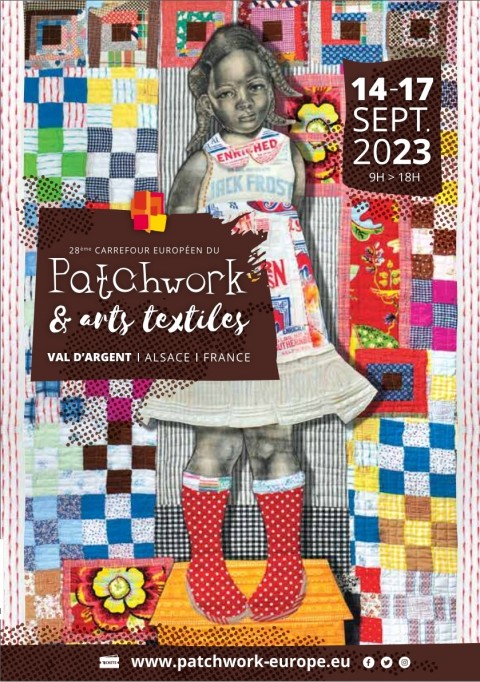 For those who still don't have enough, here is a short video, nothing special, only a few minutes of images from the exhibitions (e non solo), and on my album of 2022 di Flickr you will find other works that for reasons of space we have not included in this one post.
For those who still don't have enough, here is a short video, nothing special, only a few minutes of images from the exhibitions (e non solo), and on my album of 2022 di Flickr you will find other works that for reasons of space we have not included in this one post.
For images from previous years you can go to the Flickr pages lastoffagiusta2019 e lastoffagiusta2013.
Ringraziamenti
-
My sherpa / guide / photographer / webmaster / etc. ancora una volta, sperabilmente non l final.
-
Melanie della Sweet Home Concierge, for the courteous and punctual welcome.
-
Jupiter Pluvio, for giving us up once again.
-
TER, for its Corail carriages with comfortable sofas beyond all measure.
-
The Brasserie “Le Central” di Sélestat, once again for the unsurpassed Edelweiss.
-
The European Patchwork, for all their work and perfect organization.
-
Pastry Wach Benoît di Sélestat, for the moments of “dolce” relax
-
Our “old” Lumia with its app “Here”, to always find the way.
-
The quilters who have kindly replied to my emails.
-
Diana Marks, for some interesting information on molas.
-
Wikipedia, for everything we didn't know.
-
The village of Sélestat, not to be changed.
-
Lady Luck, for being a patient friend.


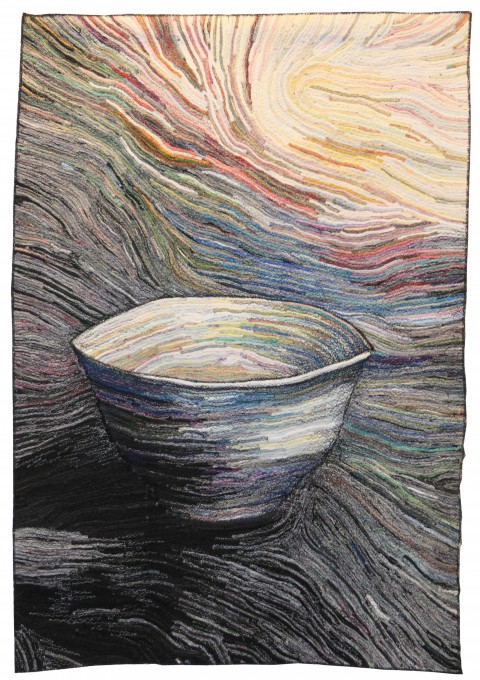
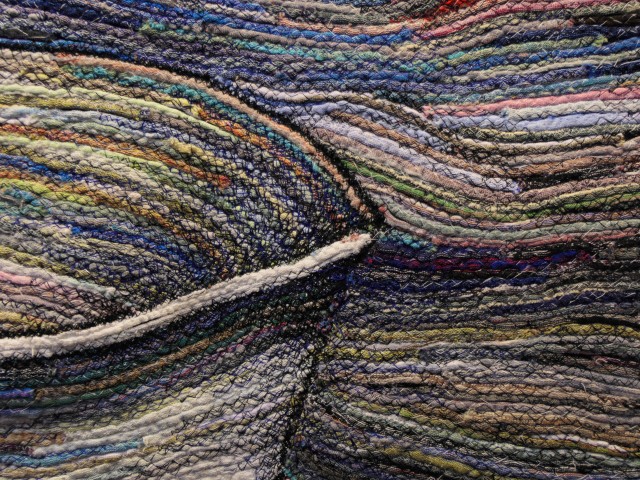
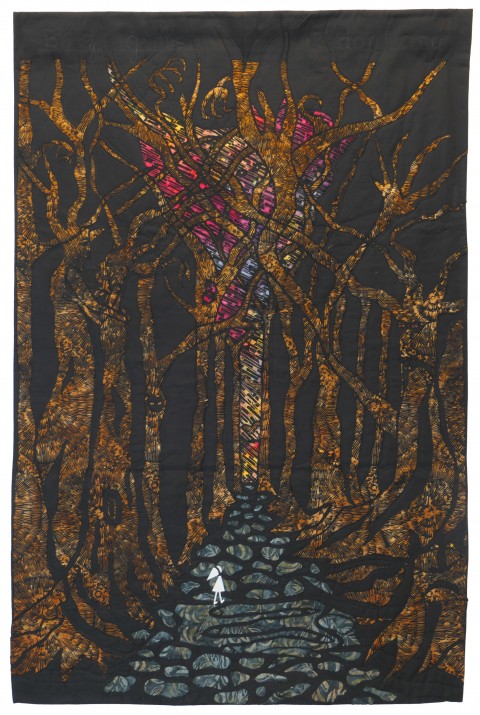
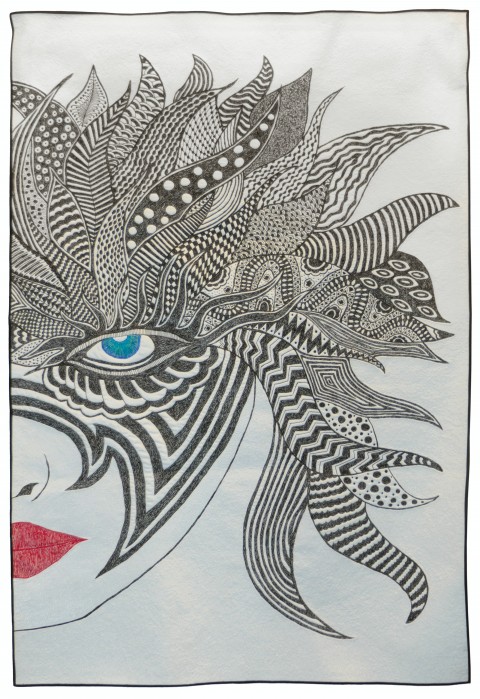
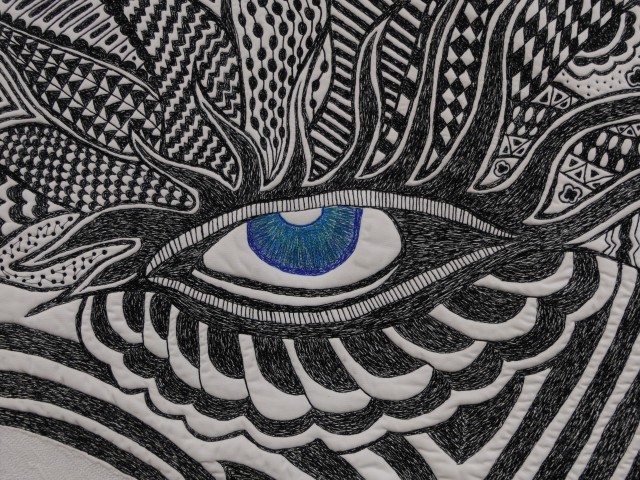
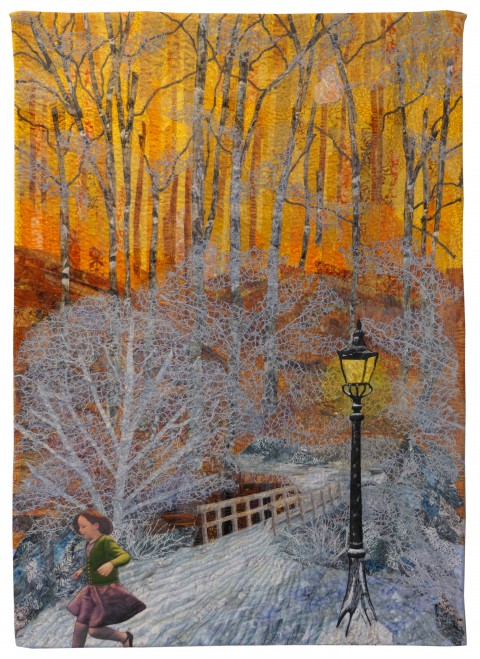
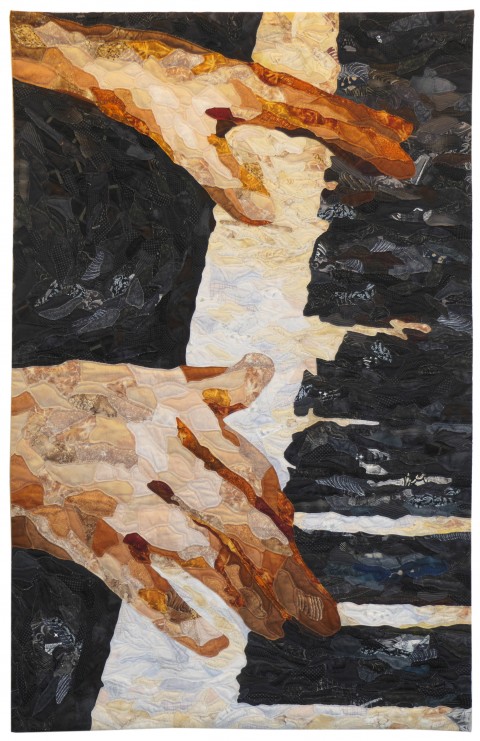
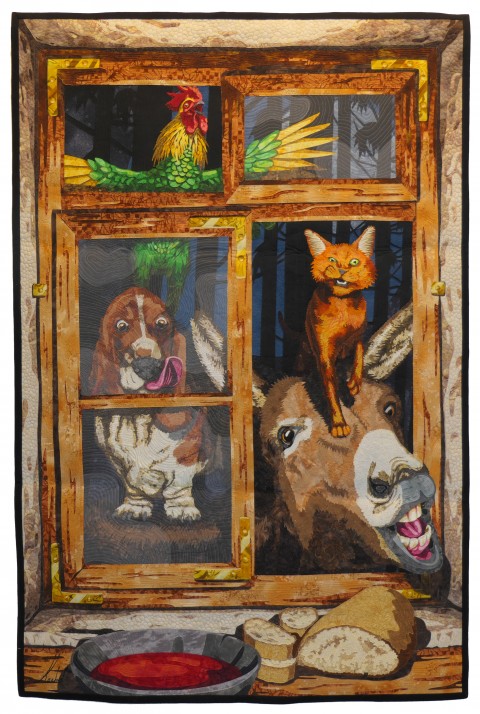
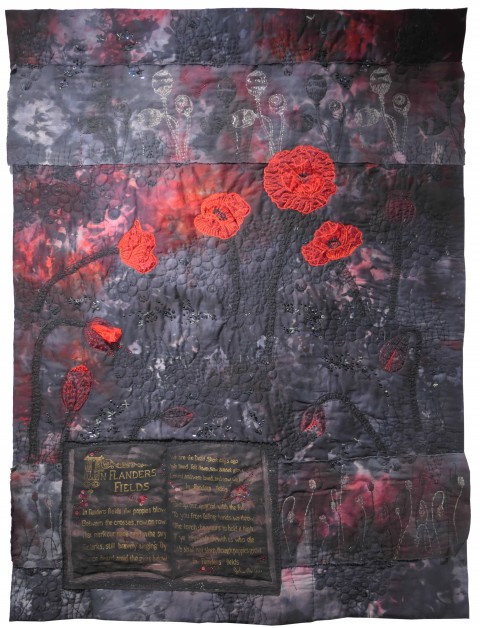
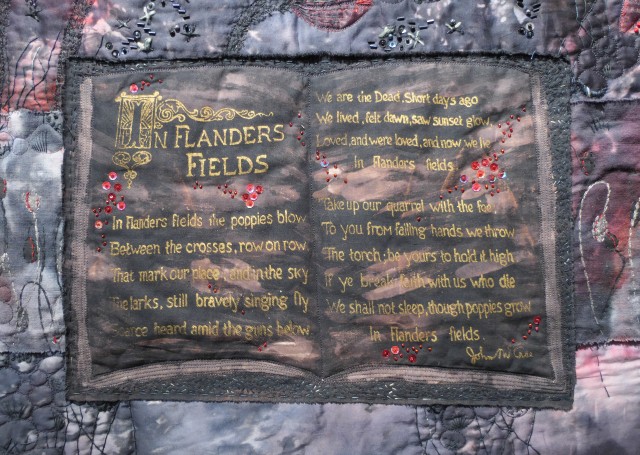
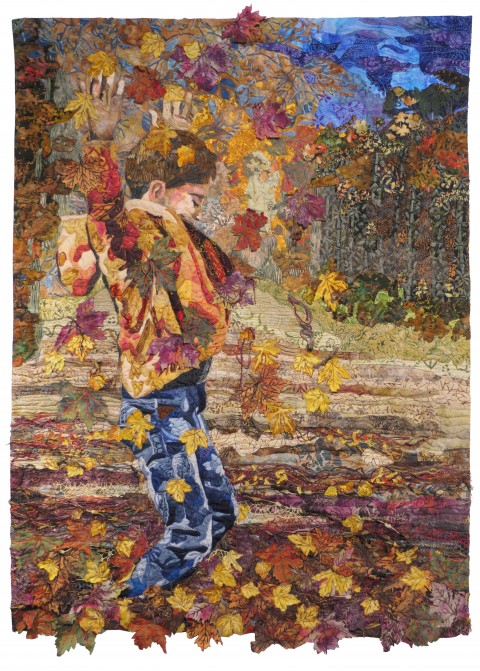
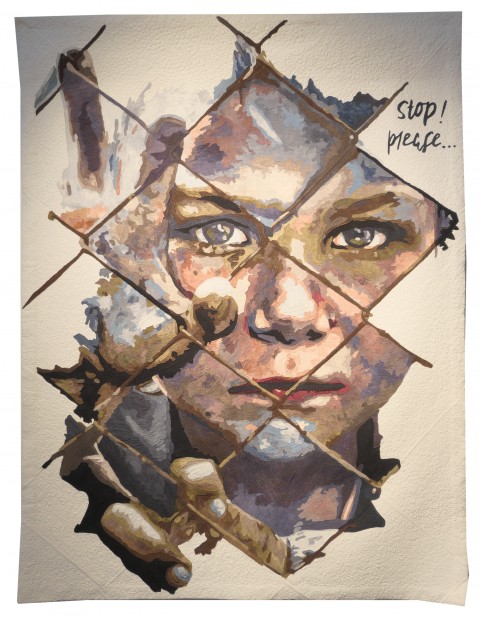
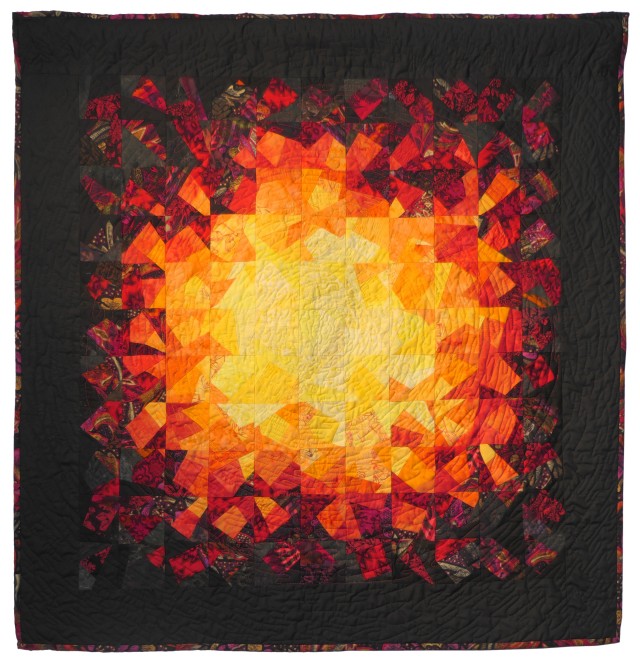
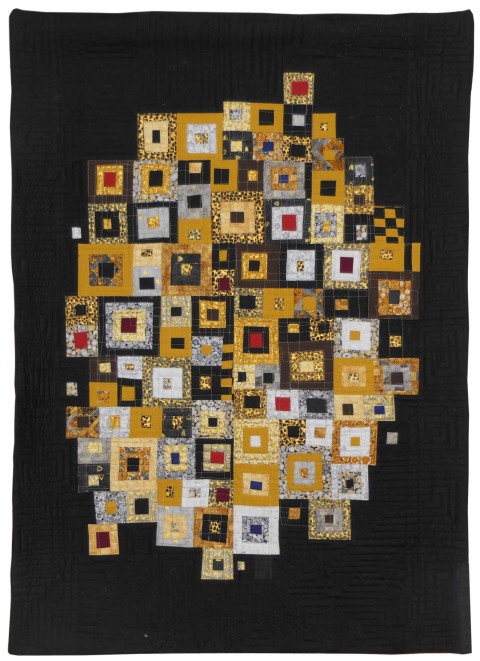
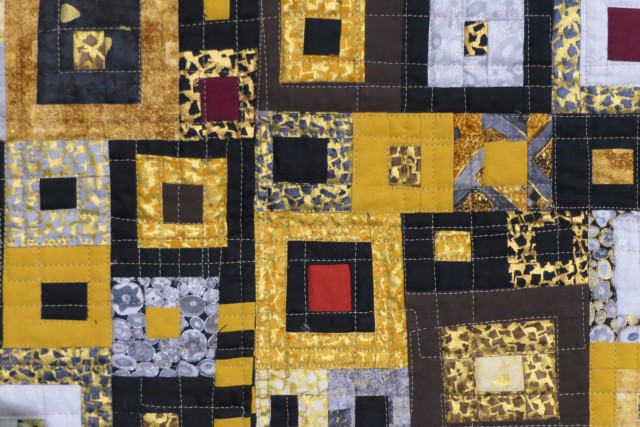
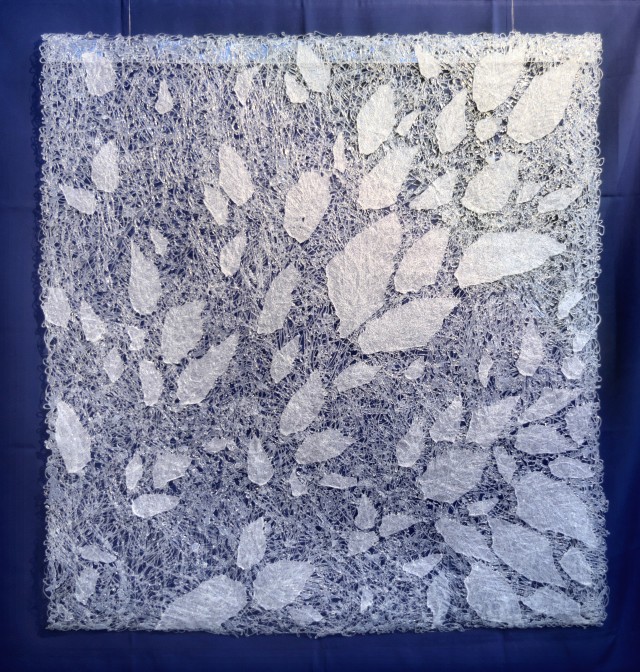
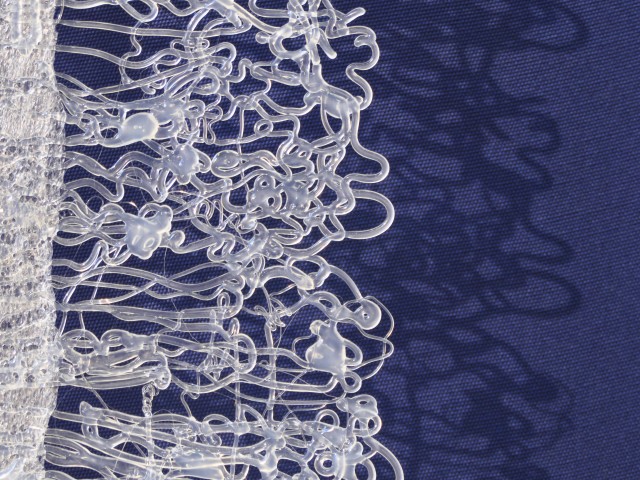
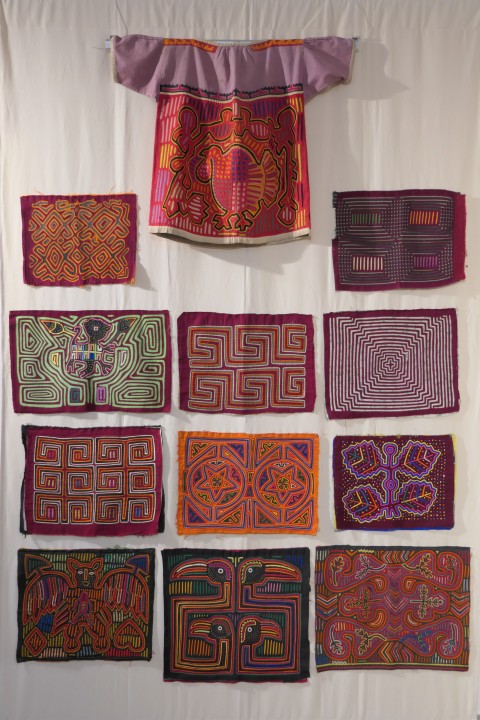
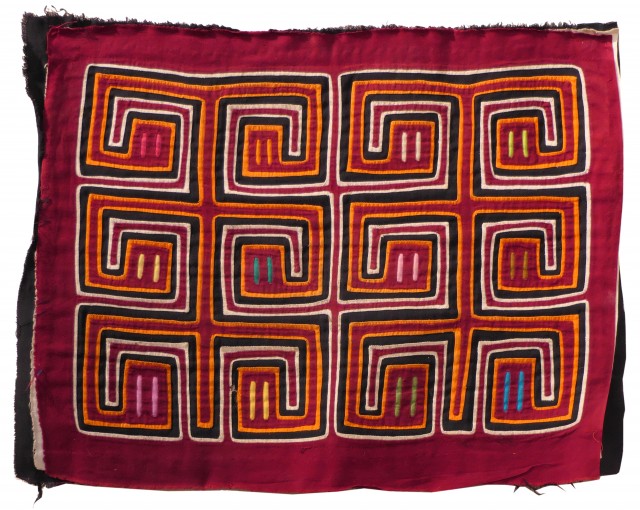
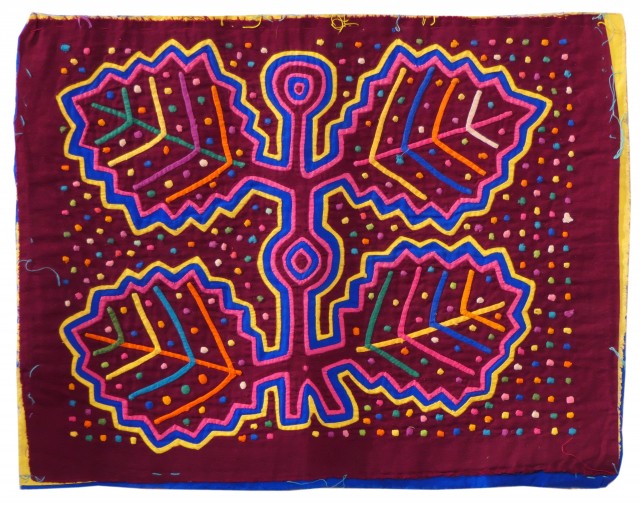
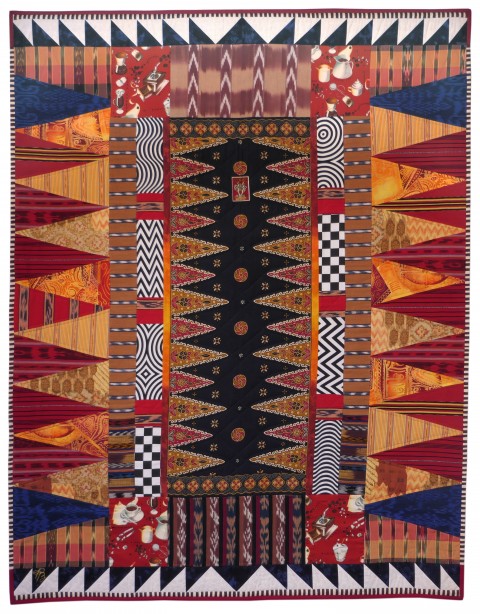
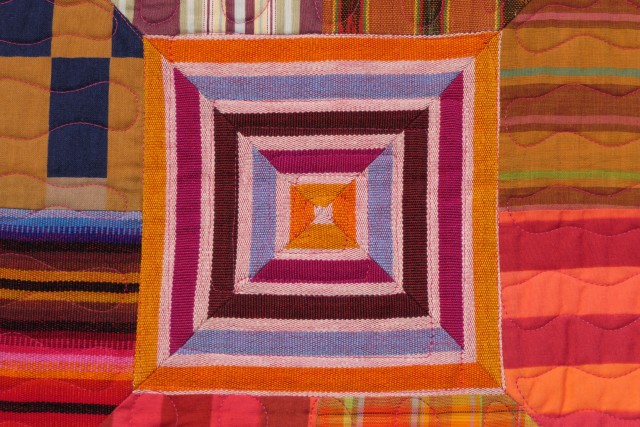
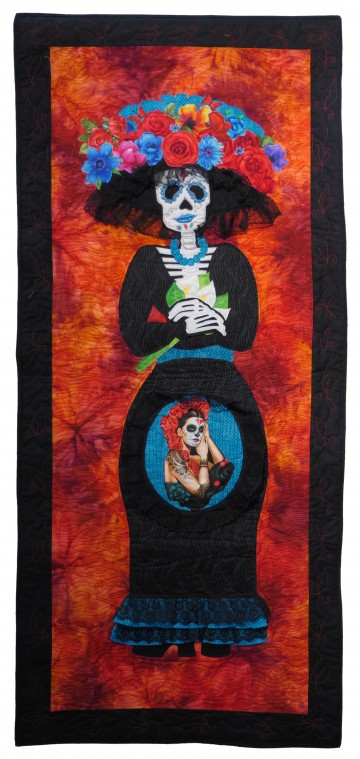
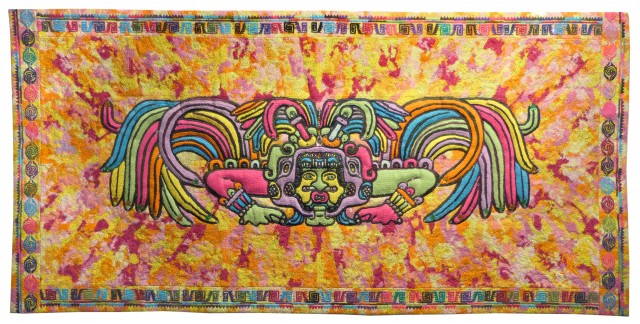
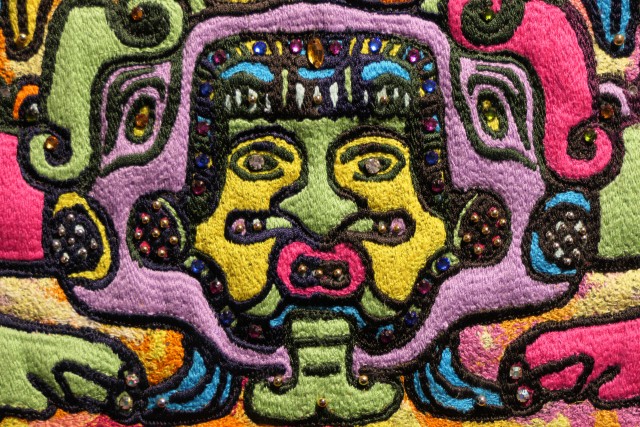
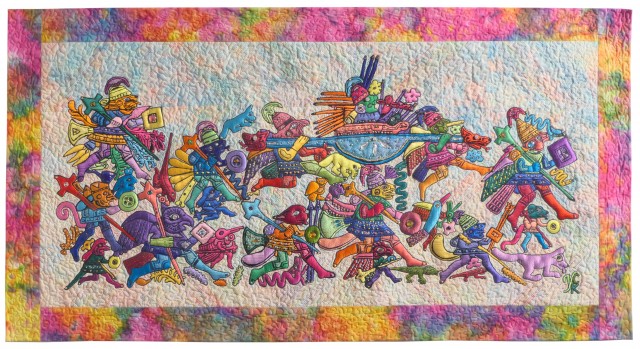
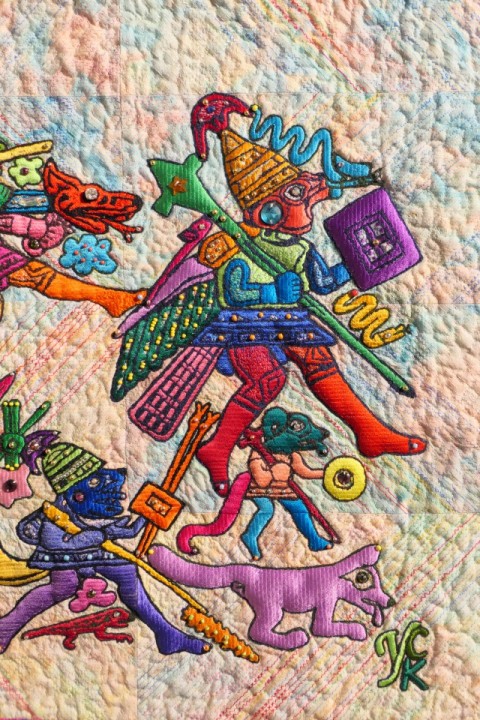
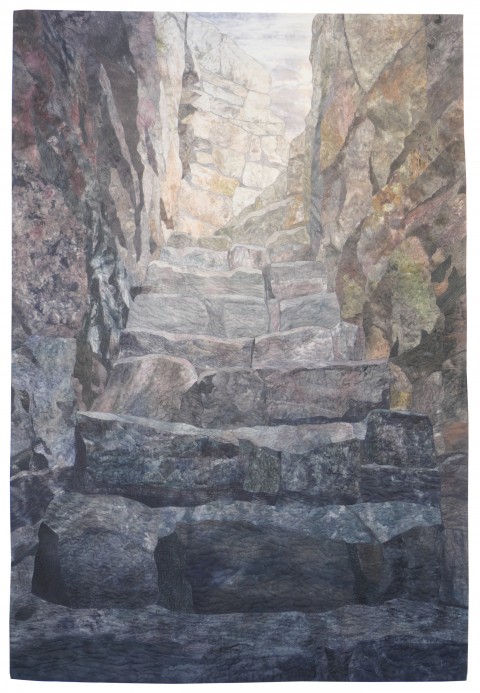
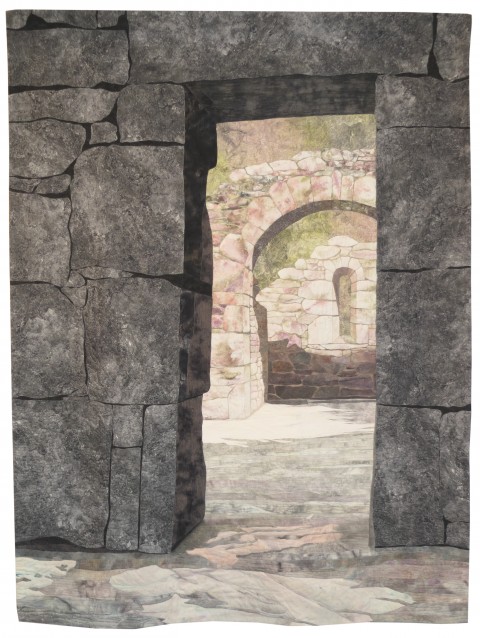
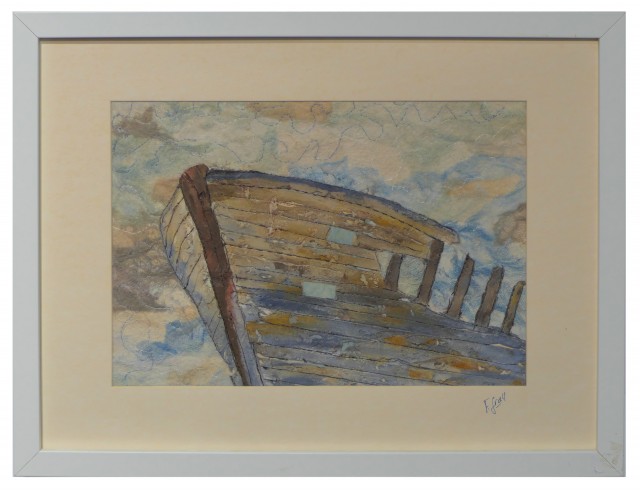
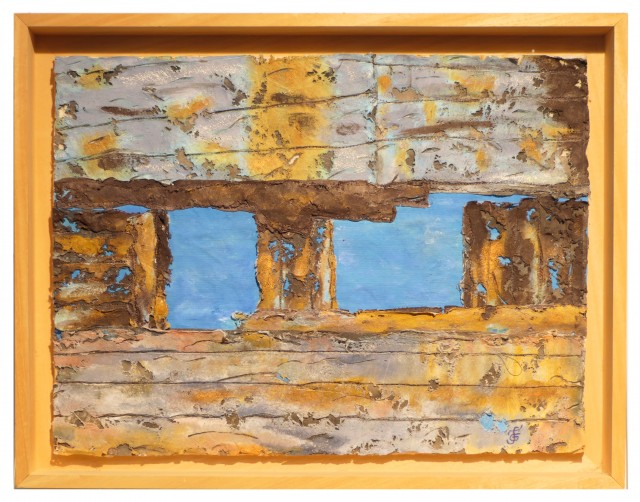
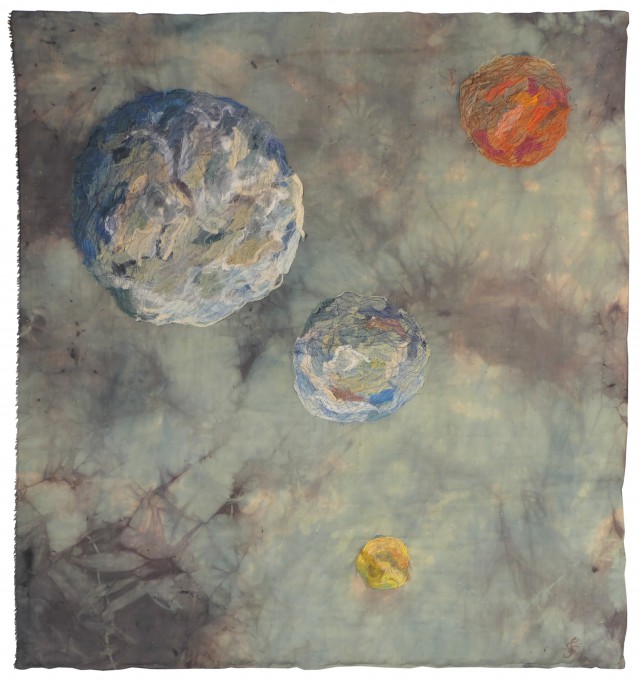
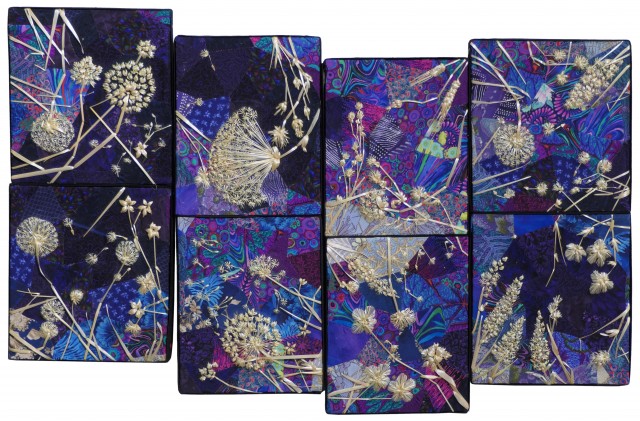
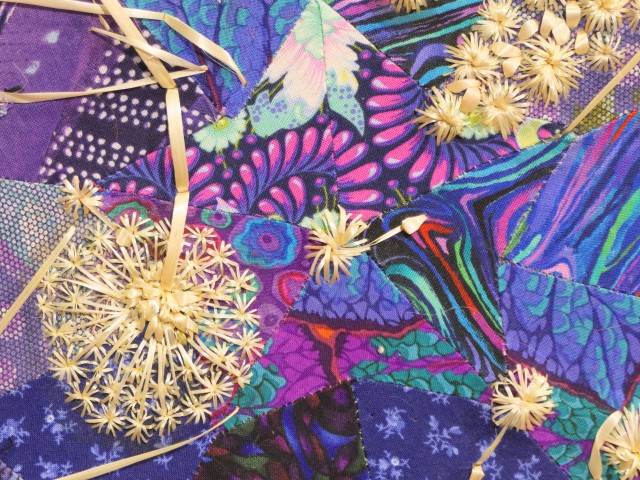
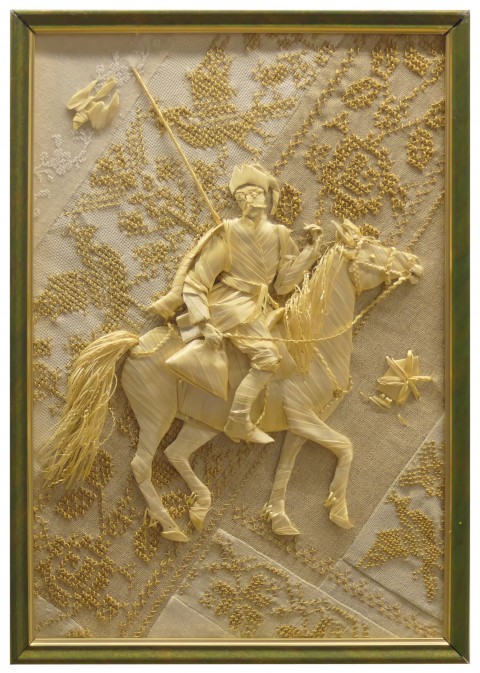
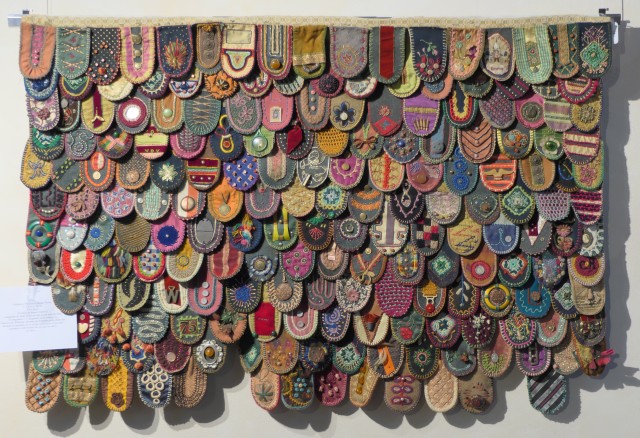

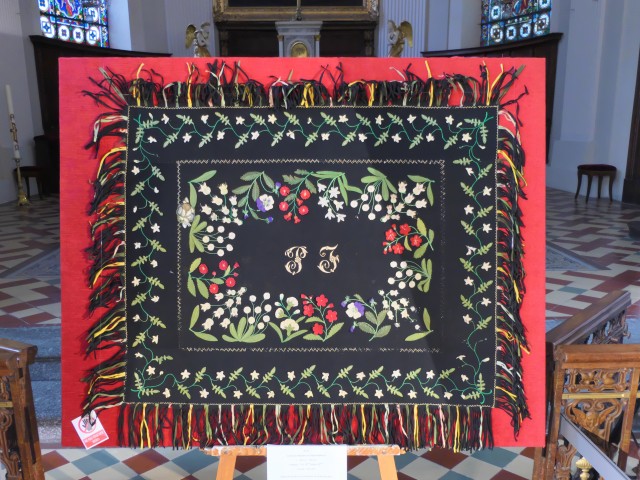
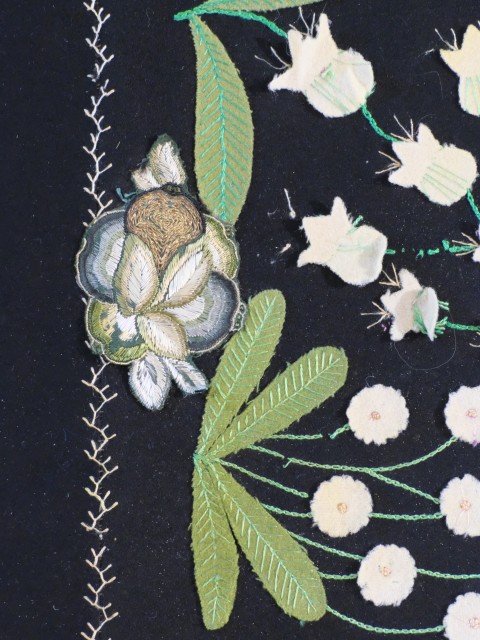
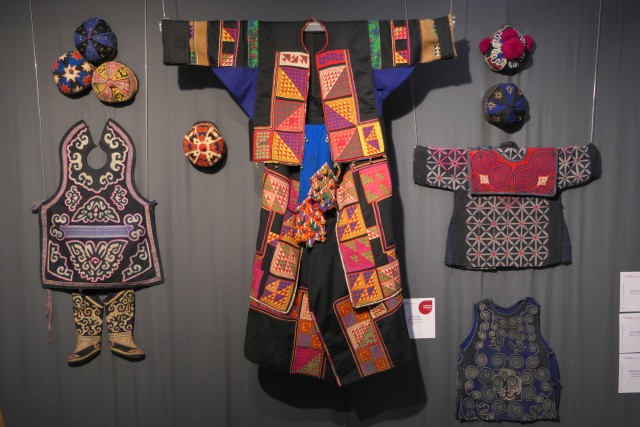
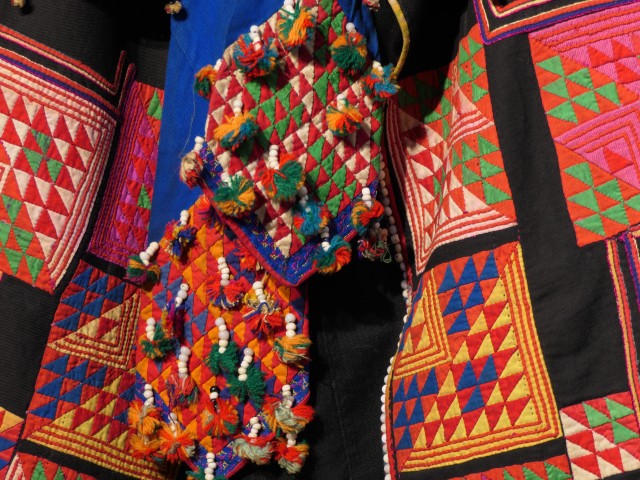
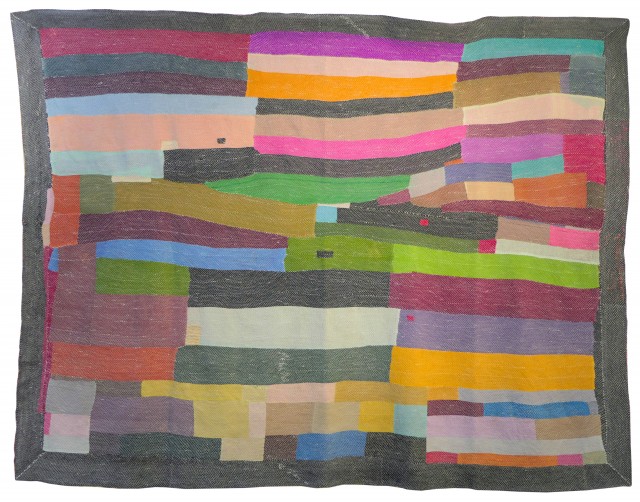
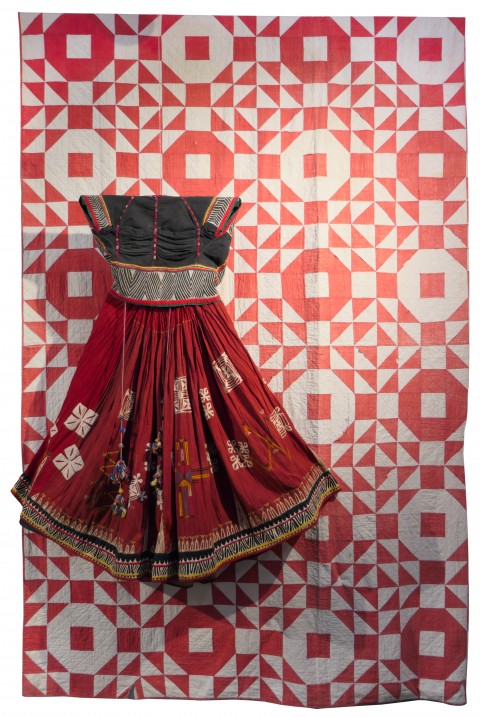
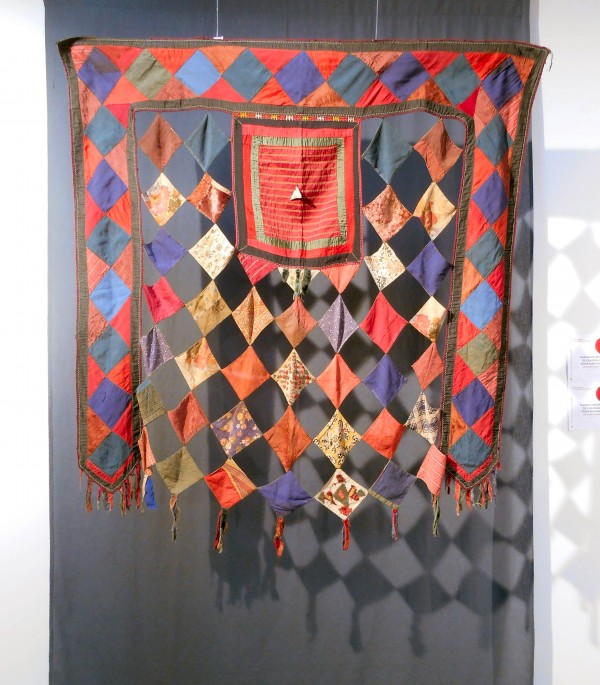
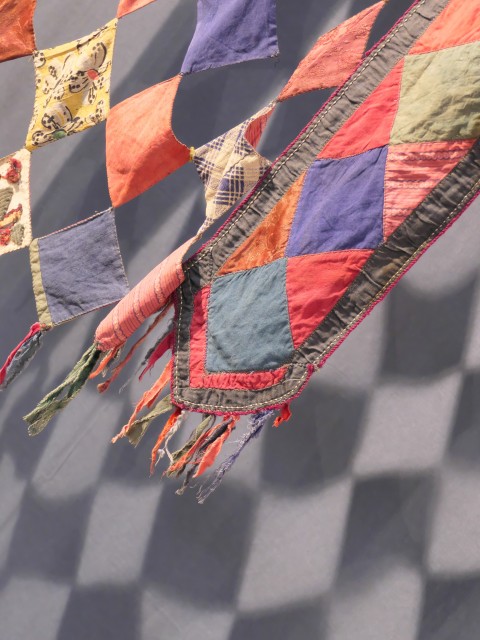
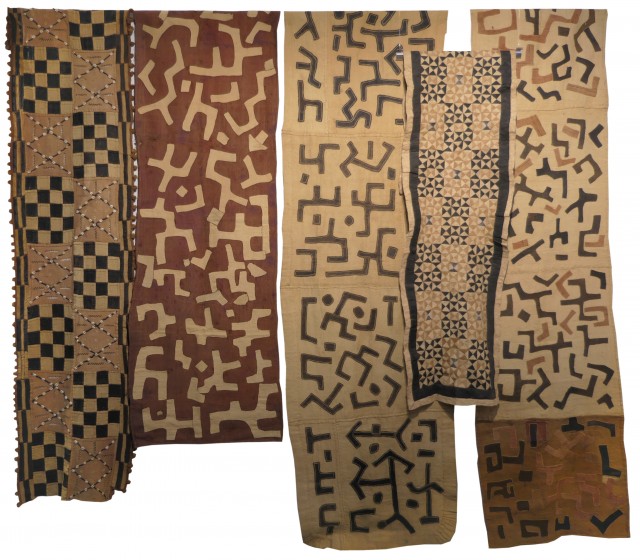
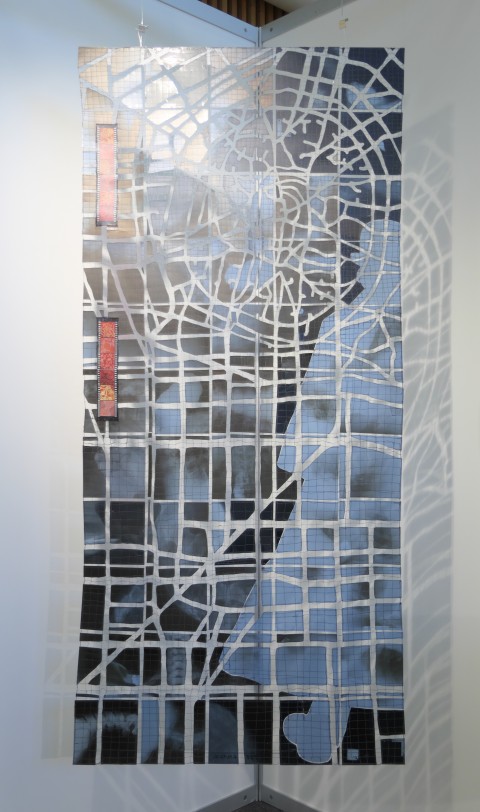
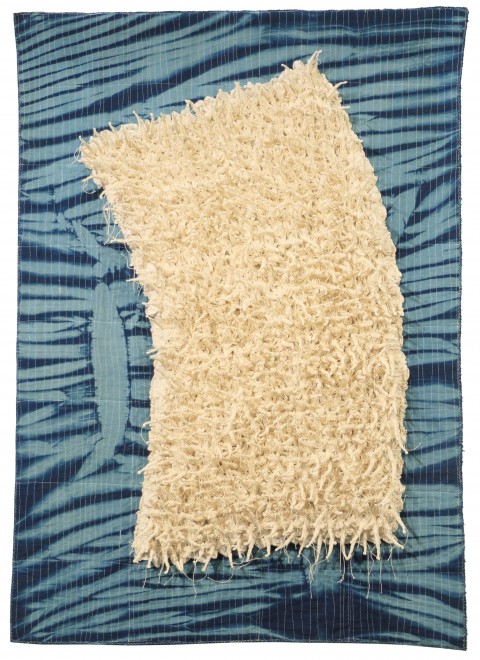
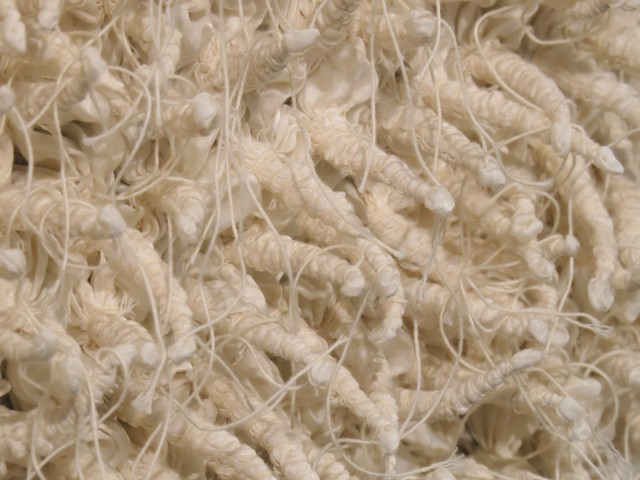
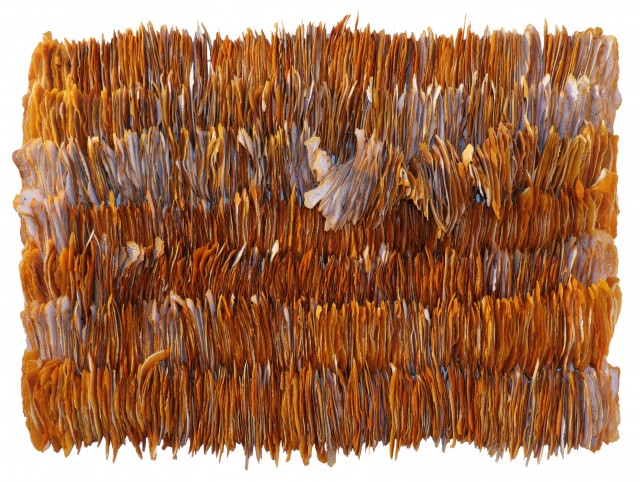
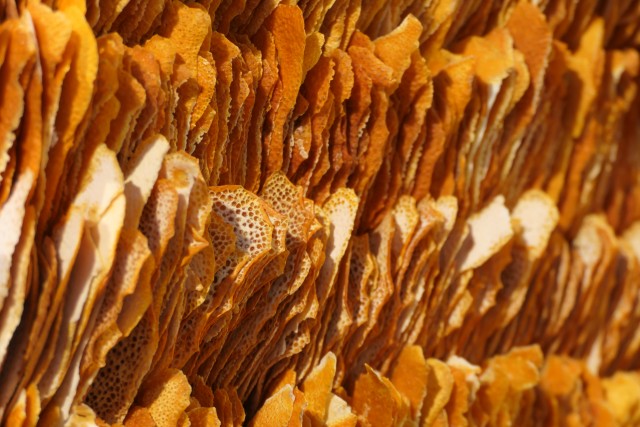
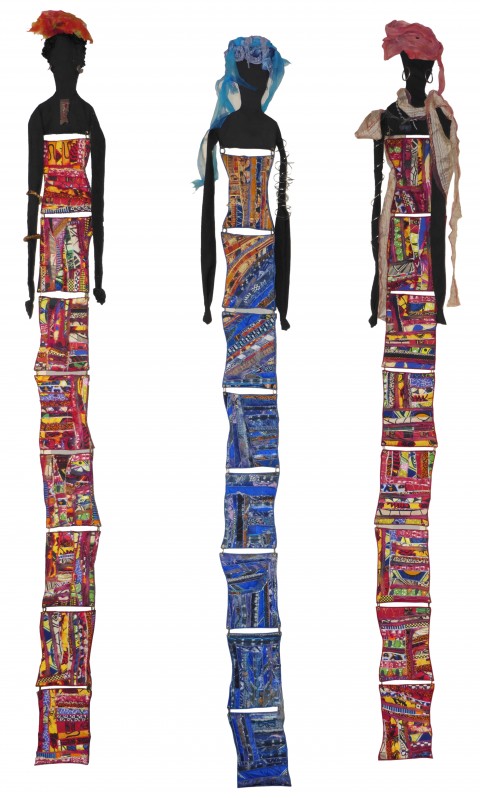
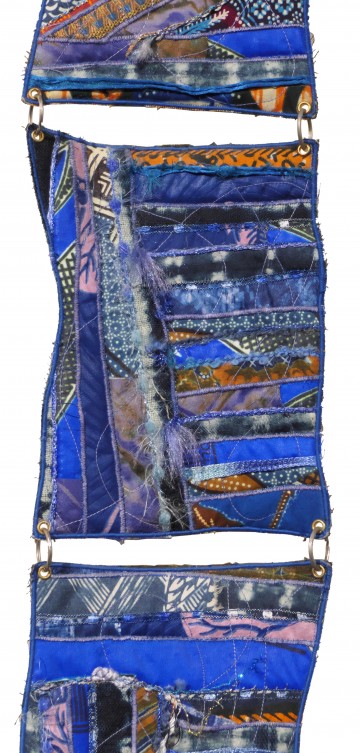

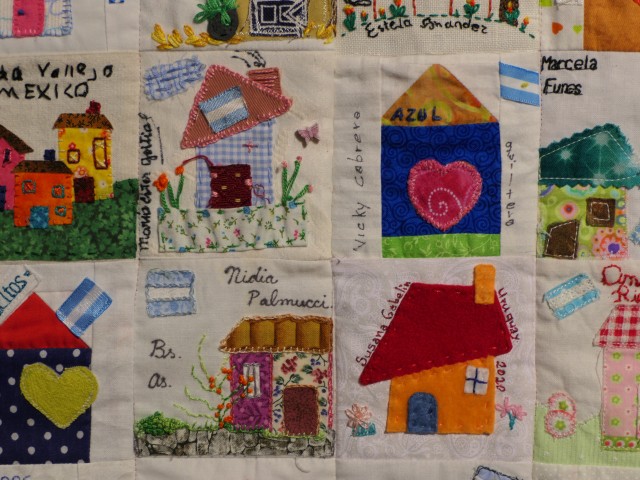
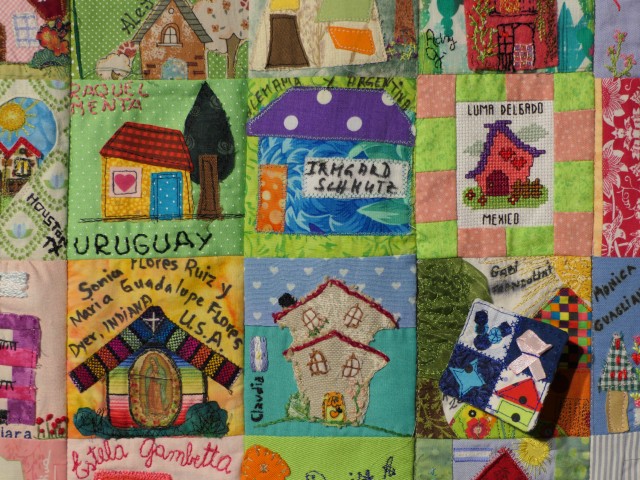
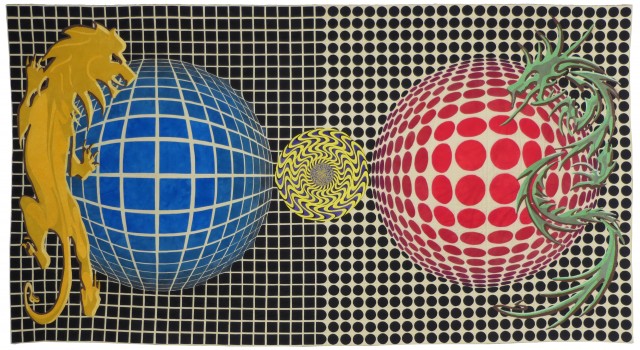
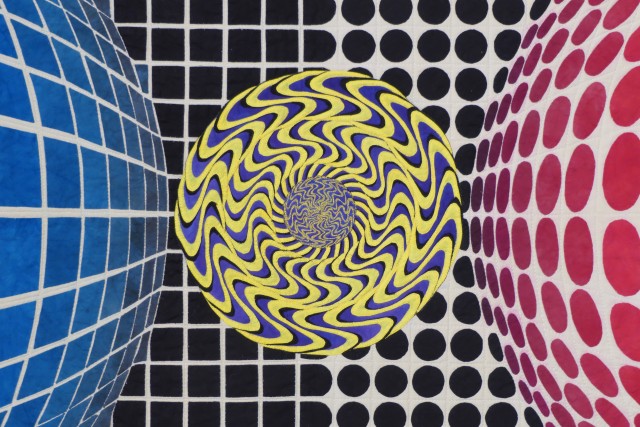
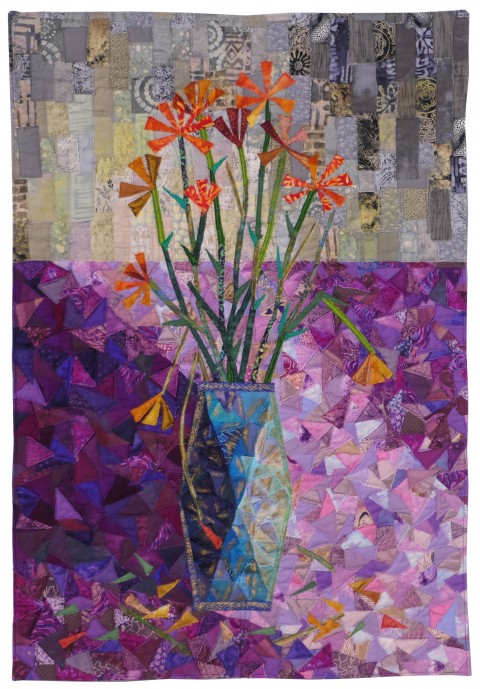
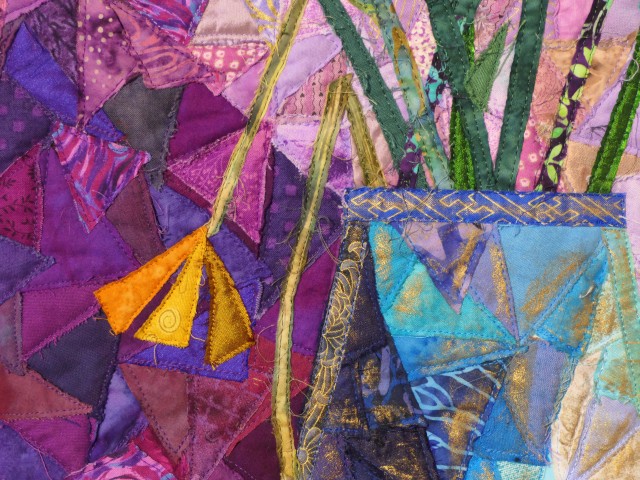
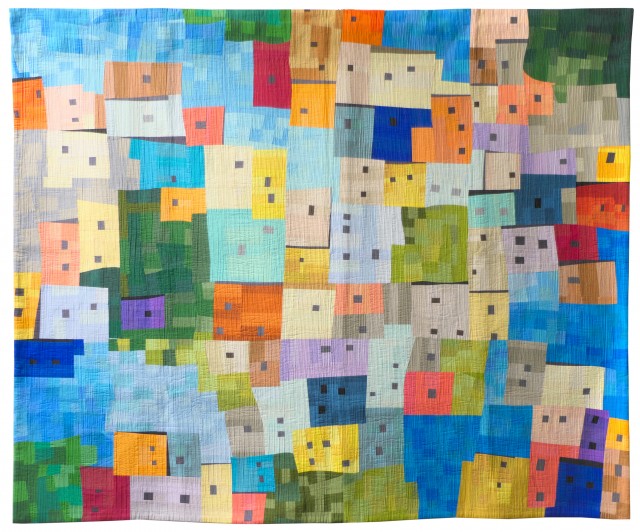
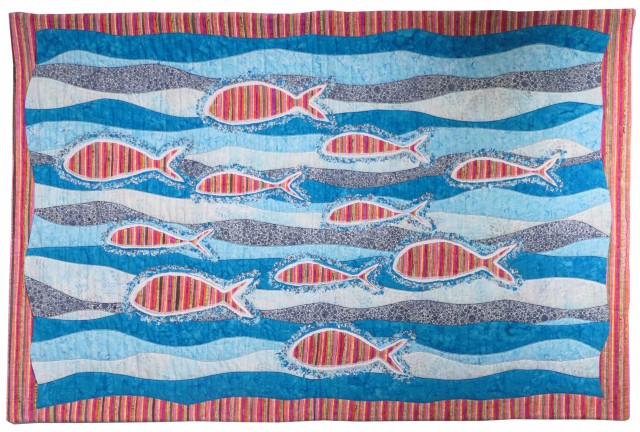
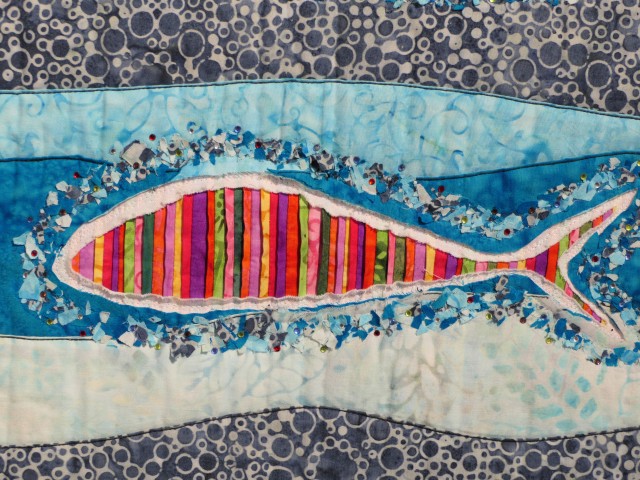
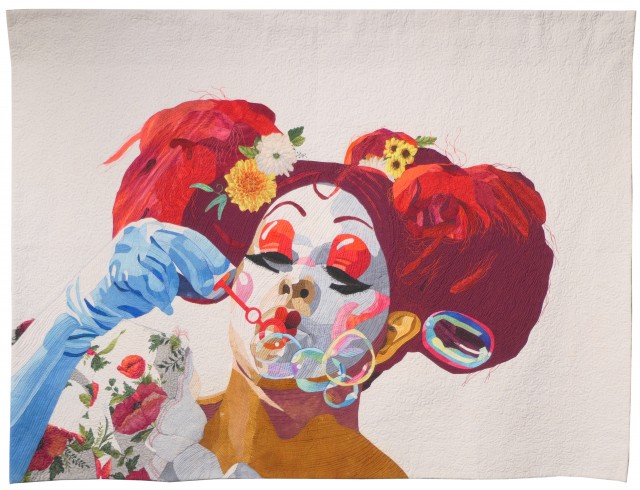
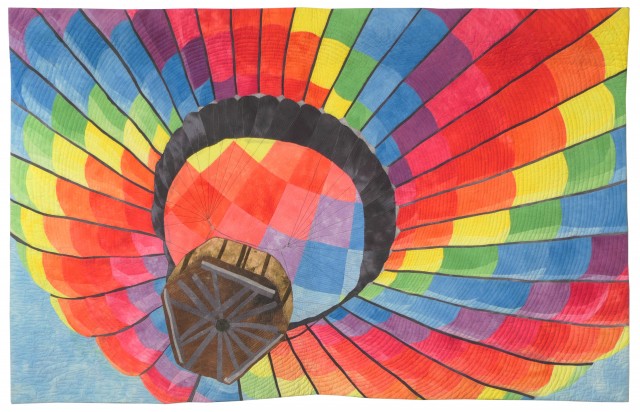
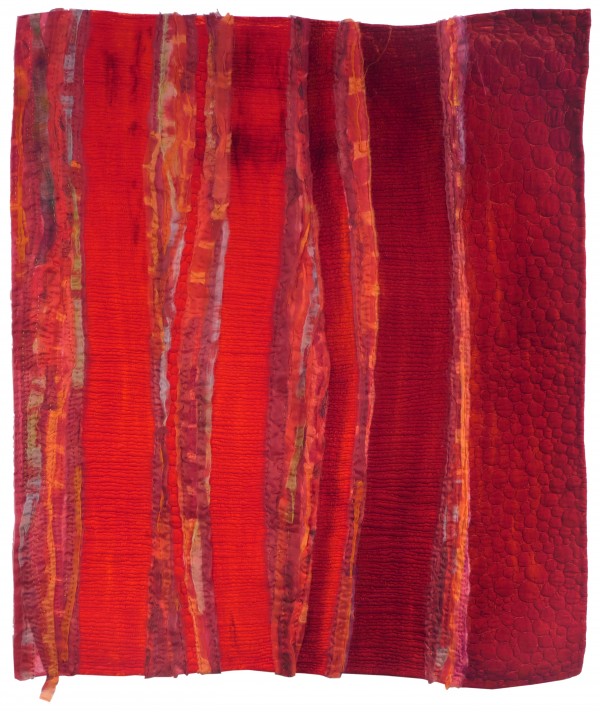
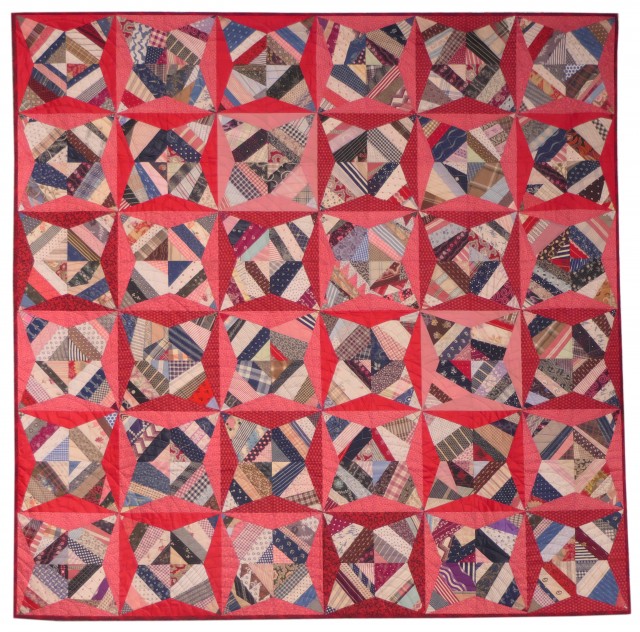
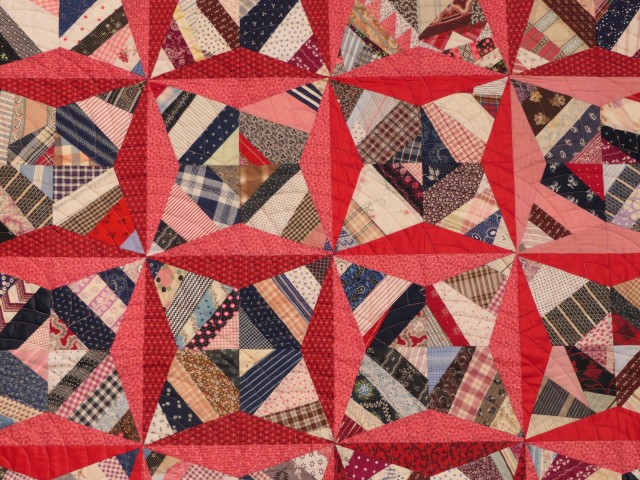
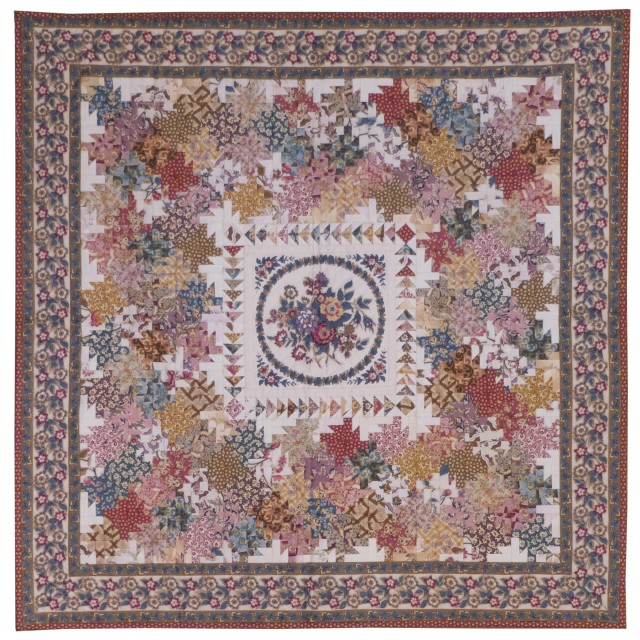
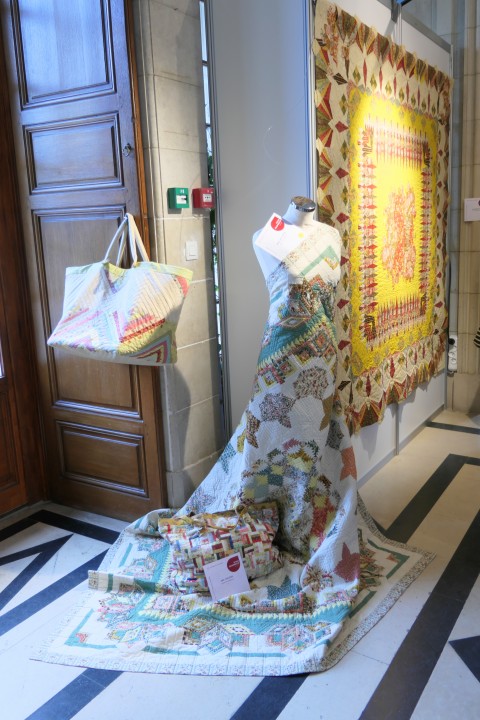
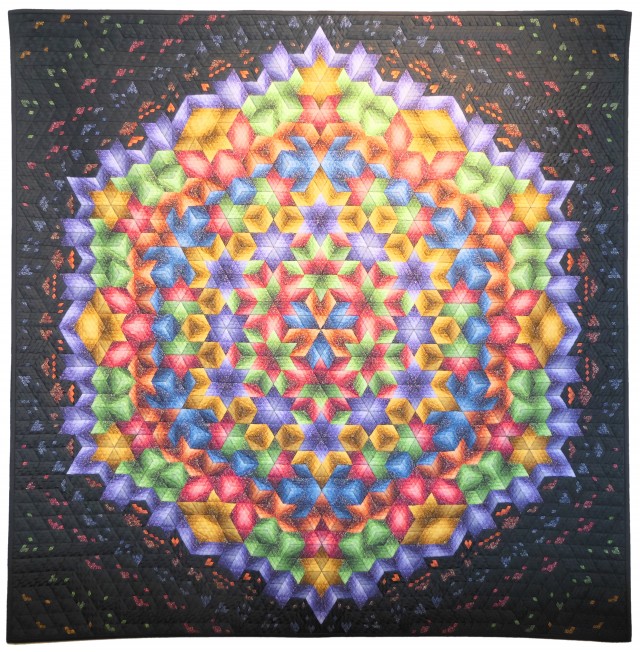
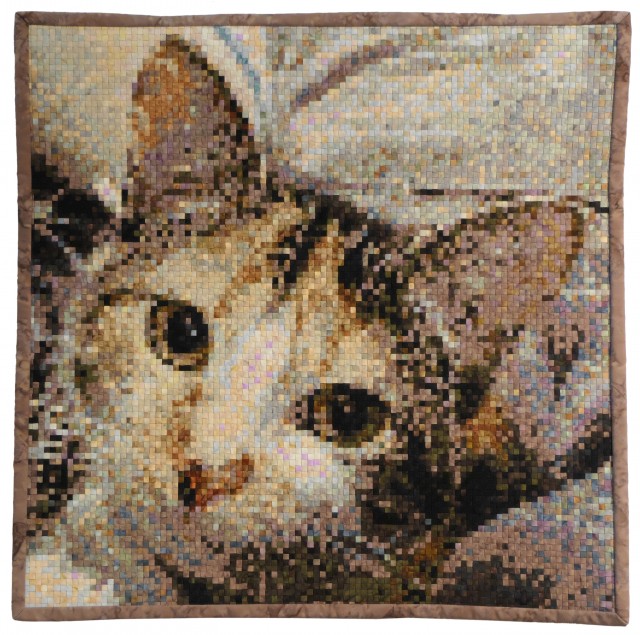
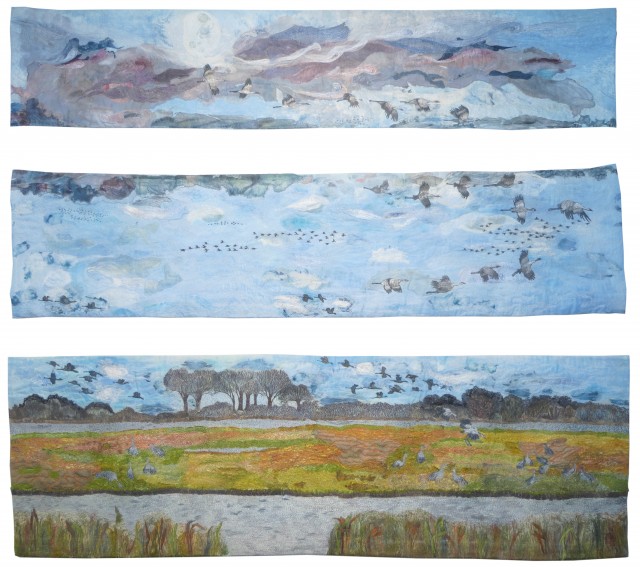
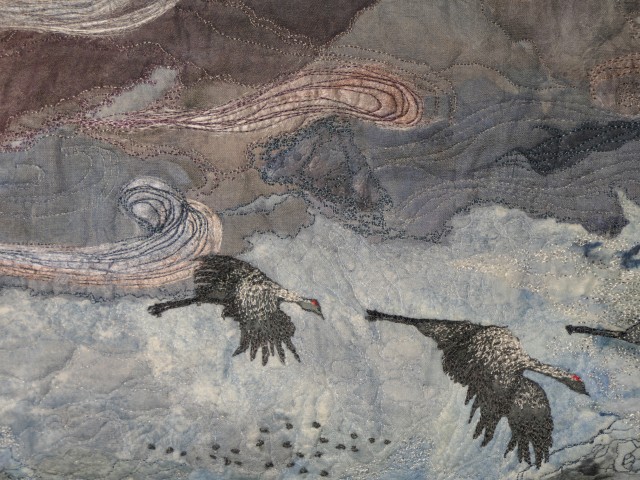
Rossana and Stelio congratulations ,I don't have this art in my hands ,ma, to my taste they are masterpieces it is always nice to look at the exhibitions and enter them with our taste, these works have their own history and can be read with the eyes and the head.
Greetings Manola
And surely you could also read them with your heart.
 Rossana
Rossana
Here I am, I'm Matthew, and the quilt is mine “Big girls don’t cry”!
Thank you thank you thank you for your beautiful words, they make me very happy.
I'm a new quilter (2018) and since I've always loved making things “diverse” and don't follow set patterns, finally this year I decided to try to enroll in a competition, and it went well! The subject came naturally to me, being autobiographical (how scared as a child)
You interpreted very well what I wanted to convey with my quilt; and if I can add something more, when you look at the quilt longer you also get a glimpse of gods “monsters” among the trees…eyes, faces, left hands, trees hugging each other. Everyone picks up different figures and monsters…that you have to learn to deal with..
My Instagram page is @teajurin and I will be present at Verona Tessile in 2023. I hope to meet you there! Thanks again
Ciao, I can tell you that the tangle of forest trunks and branches conveys a sense of threat already at first sight. This is one of the merits of your work as fear does not need to be observed in detail to have its effects, on the contrary, the more elusive it appears in its design, the more it promises to be invincible. If not, as in your artistic representation, by observing closely one could discover that a claw is only a fragile twig, a log is simply firewood, and a forest is nothing more than a series of individual elements that arise from the ground (or over time) for their purpose which inevitably escapes us.
Congratulations again.